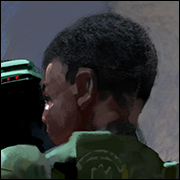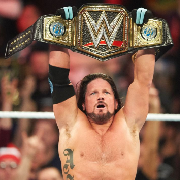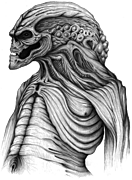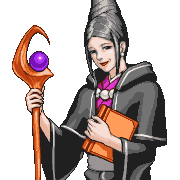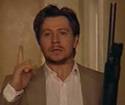|
I don't remember if this was mentioned in the previous thread but it's striking how skull-like Que's face is. He's possibly the least violent and goofiest of the Autobots in this movie, plus the super-sappy melodrama when he faces his execution, yet he looks like a ghoul. I'm not sure what that's about.
|
|
|
|

|
| # ? Apr 20, 2024 06:18 |
Monkeyseesaw posted:I don't remember if this was mentioned in the previous thread but it's striking how skull-like Que's face is. He's possibly the least violent and goofiest of the Autobots in this movie, plus the super-sappy melodrama when he faces his execution, yet he looks like a ghoul. I'm not sure what that's about. A funny little green ghoul? 
|
|
|
|
|
Say what you want about Bay but he seems to enjoy making these spectacle pieces a whole drat lot.
|
|
|
|
Yessss! This thread is back. I'll give it a detailed read - I've only briefly skipped Terry's amazing posts at this point - as soon as I wake up tomorrow.
|
|
|
|
|
Monkeyseesaw posted:I don't remember if this was mentioned in the previous thread but it's striking how skull-like Que's face is. He's possibly the least violent and goofiest of the Autobots in this movie, plus the super-sappy melodrama when he faces his execution, yet he looks like a ghoul. I'm not sure what that's about.
|
|
|
|
Fin: “Was it all worth it?” I deliberated a lot on how to present the last bit of the movie. At first, I wanted to do it in two parts, commenting on things as they came up, like before. But to be honest, I wouldn't even be sure what to say during most of it. These fifteen minutes are such a complete experience that trying to comment on them in such a fragmented manner would be useless. I'll try something a bit different. Let’s start by watching the conclusion in full. You have no idea how much trouble trying to make this video on my disintegrating laptop caused me, so you better watch it! Throughout the making of this series, I spent a lot of time watching the movies. I saw each one twice before even starting to write, once blind and then knowing how the trilogy goes. Examining scenes in detail, going back and forth to find good screenshots (not easy, considering how much of the movies is covered in indistinguishable motion blur!), looking up things I’d forgotten... If you add all that up, I have probably watched the full runtime of Dark of the Moon eight or nine times. Quite frankly, I could do without ever seeing Shia Labeouf’s face again. I have watched these 15 minutes a lot more often than that. And every time, I would enjoy them just as much as on my first viewing. It’s just so... Joyful. There’s so much detail, such elegant motion, the sound design and pacing are flawless. It starts out fairly low-key with the army setting their explosives, then tension progressively intensifies as they swarm and overwhelm the Decepticons more and more, both smoothly leading into and starkly contrasting against Optimus Prime’s particular kind of dynamism as he swoops in to cut a mile-long bloody swath in just three near-seamless shots. The constantly moving camera captures this momentum and carries it forward through the seemingly more stationary/quiet shots, so the fight between Optimus and Sentinel can pick up without any perceived break in the action occurring. That wonderful shot of Carly just standing, open-mouthed, in the middle of that apocalyptic chaos she is simply unable to process forms the perfect punctuation to it, and the camera finally slows down to linger on Megatron’s earthy, solid form.* Thinking back to the big “action sequence” of the first movie, whose sole emotional content was a sense of vague contempt, it’s strange just how completely inadequate it is compared to this – beautiful, overwhelming, cathartic and yet somehow very tragic. It’s a labour of pure love and great attention to every little detail. I’m gushing, yes. But for me personally, these fifteen minutes, and the instant we see Megatron’s head hit the ground, ended up justifying the entire trilogy. *His shots create short "breathers" in the action by contrasting against it visually and letting the movie slow down a little. It's an identical effect to what the film normally uses churches for, making his body a sort of "sanctuary". Before I get into the important poo poo, just some minor notes: - We really see the new human strategy in motion here. Making use of their small size and mobility, they scurry about like ants, swarming the much grander machines from little nooks and hiding spots, targeting their weak spots, and effectively defeating the great Shockwave with something as incredibly profane as a large sheet of cloth. In a strange way, their far superior opponents end up being completely defenceless... It’s hard not to pity them, really. The Autobots actually accomplish less than the human soldiers do, too. - Sentinel is totally ignorant of his ground troops being defeated. He doesn’t even see it. - Notice the random Constructicon towards the end of Optimus’ rampage? That’s Scrapper! No reason for him to be there, except maybe to remind us that he’s also elsewhere in the movie, in a way... - I made a big deal before about how the pillar they end up fighting over isn’t actually the control pillar, but, well, turns out it is. - Sentinel twirling his swords about Darth Maul-style is so silly. Really though, the Optimus vs. Sentinel fight is one of the few fights in the trilogy that isn’t just a one-sided beatdown. Funny, that. - lol Sam abandoning his girlfriend in the middle of a battlefield - not-Garbage Day makes his last appearance. I wish we’d actually seen him in a way that makes him actually visually distinguishable. - lol that static gun shot straight out of an FPS - The Primes’ battle dialogue is very telling. “You were always the bravest of us!” Of interest: In an early episode of the 2008 TV Show Transformers Animated, Ratchet tells a somewhat different Optimus Prime: “Heroes are the ones who make the hard choices.” Also, what kind of reaction to “Our planet will survive!” is ”No!”!? - Notice how Optimus totally loses his composure the instant things start going poorly for him. Right, now, about that important poo poo. Let’s look back for a second, shall we? 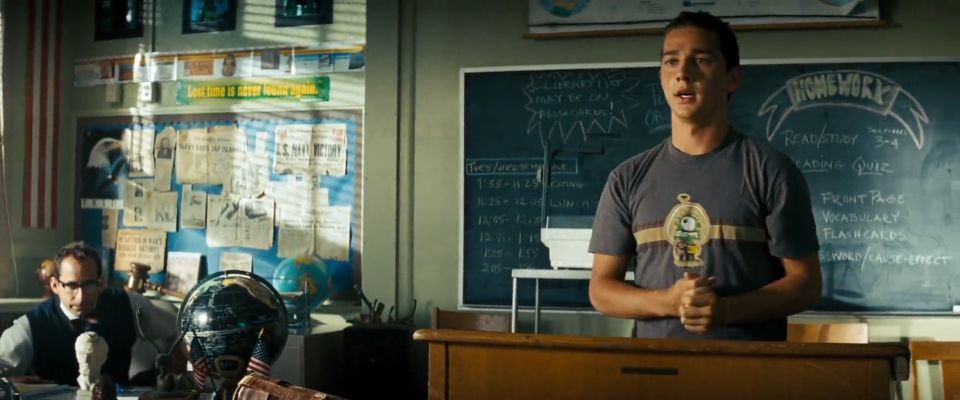 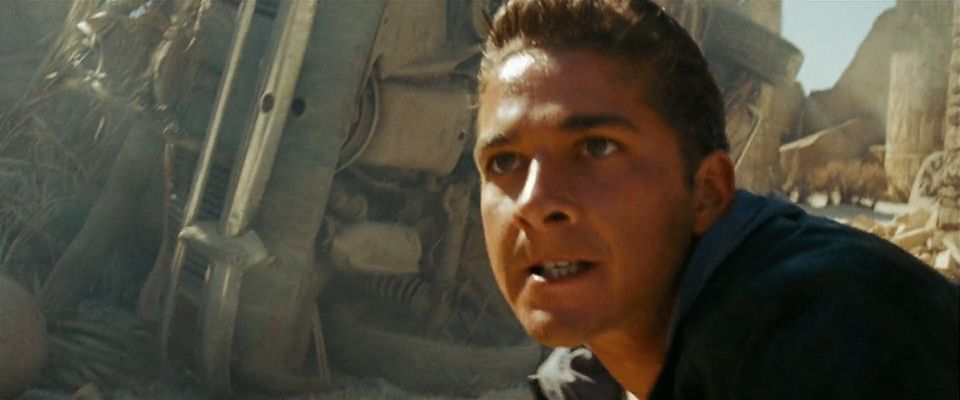 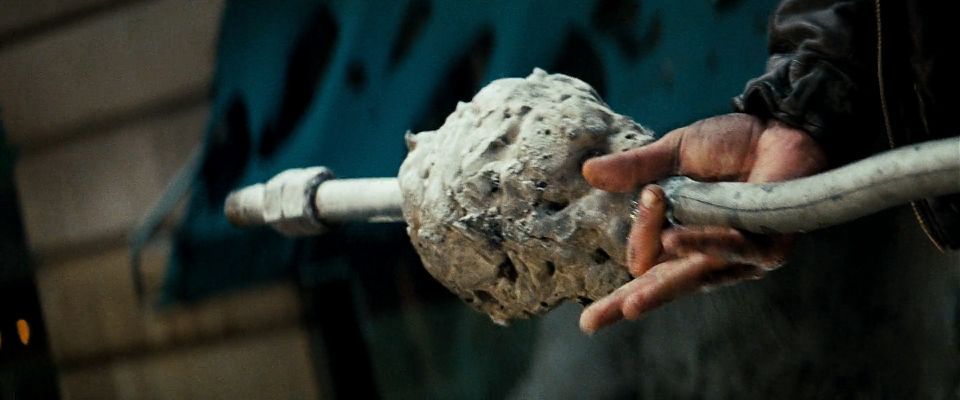 (Music!) Sam Witwicky was never a terribly sympathetic character. In the first movie, he was an idiot, and a bit lacking in empathy, but you know, he was a kid. It’s just what teenagers are. We all were a little dumb once, so it’s entirely possible to relate to him on some level. He is then thrust into a situation well over his head through nothing but dumb unluckiness, and finds himself having to fend for his life before even learning how to talk to a girl. Over the course of three movies, we see him steadily degenerate into an abhuman, unlikeable psychopath. The films dedicate a great amount of time to showing this development, and in a sense it could be seen as their main focus. We see a boy who, through virtually no involvement of his own, ends up being rewarded with the ideal dream of every boy his age – he gets the girl, the car, the recognition. Not just any girl, but basically a supermodel. Not just any car, but an incredibly expensive unique hypermodern concept supercar oh and also it’s sentient and turns into a giant fighting robot. In a sense, he ends up at the goal without actually having fought his way there. Without having learned and grown as a person. At the beginning of the second movie, he seems to realise this, making an active effort to distance himself from Mikaela and Bumblebee. But it’s useless. Dylan accuses him of choosing the wrong side, but the sad irony of his statement is that neither of them ever had a choice. Dylan himself was pretty much forced at gunpoint to work for the Decepticons. It really is as simple as that. But it’s also incompatible with his entire worldview, the randian idea of the self-made man, so he ends up attempting to rationalise it – as his choice, as a business decision, all that jazz. Basically his entire dialogue throughout the movie is him trying to justify his betrayal of mankind, not to Sam, but to himself. “This is the only future for me!” is his last outcry of existential despair over how little control he actually has over his life. The one that is taken from him right after. Dylan is a parallel to Sam because Sam is effectively the same. Back when he was just an impressionable teenager, the very instant he first encountered one of these wondrous alien beings, he was immediately offered a one-sided narrative that pulled him into Optimus’ grasp. Tempted into loyalty by being given everything he wanted, he was secure in his little web of closed perspectives, seeing only those parts of the conflict that confirmed his biases. He was never offered an alternative viewpoint, and never sought one out himself – because he never even knew there was another viewpoint. Good guys, bad guys, life is just that simple. He never made a choice because he never knew he had another option. Particularly in Revenge, Sam is very much portrayed as a victim, both a victim of coercion (being dragged back into the war against his will) and, well, an actual victim of said war. His death and rebirth leaves him a hollow, burnt-out shell bereft of all that makes him human, and his behaviour in this movie reflects this. And in the end, he faces a victim just the same as him, and makes the decision to kill him. Now, this cannot be overstated. Sam was already responsible for the deaths of Megatron and Starscream, but both of these were panicked acts of self-defence, and, as far as he was concerned, he had no other choice. But this is different. Killing Dylan made no difference. It didn’t stop the pillars or the Decepticon plans, it didn’t weaken them, indeed, there was no necessity for this death to happen at all, because after this, Dylan would have been free. Yet Sam faces him down and, in full awareness, decides that he has the right to take this man’s life. That’s the climax of his character arc. After three movies, of which most screentime is devoted to him, the culmination of all his development and everything he went through is a shot of him, standing there, open-mouthed and with a totally vacant expression, over the man whose ribcage he just crushed. He fully admits he’s not a hero, or someone who matters – he’s nobody. That’s it. That is the image we take away from him. The main reason I highlighted Duel is because it presents the perfect contrast to Sam’s story. David Mann is an insecure loser who, by transgressing his inner inhibitions and barriers, grows past himself and becomes a better person for it. It’s a simple example of a common narrative in action movies, really. Perhaps taught by these, Sam effectively attempts to repeat the same strategy: He breaks his final inner barrier and defies the simplest and most fundamental moral commandment of humanity, and goes where most of us (thankfully) do not dare tread. But it gives him nothing. He doesn’t become a better or stronger person, but merely even more hollow than he was before. Because he had no goal. He had nowhere to go to, because he never learned what being a strong person actually means. His life is a dead-end scenario, and no amount of beating his head against the wall is going to change that. In presenting Sam as the audience surrogate, the films effectively state that you, yes, you, are in a situation analogous to Sam. That’s a rough loving accusation to make. There is little seriously hidden or subtextual about this; The movie steps just two words short of outright saying: “Given the right circumstances, you, too, will become a remorseless murderer.” Yeeeesh. Unfortunately, the severe punch of this accusation is softened by the fact that, well, Sam’s portions of the movies are the weakest part of them by far. They’re just spread too thin and their focus is all over the place, and considering how simple (by these movies’ standard) his narrative turns out to be, the amount of reverse-engineering you have to do to arrive at it is rather disproportinate. A big reason for this is Dylan’s character. I criticised him before, and really, he’s one of the major reasons this film’s treatment of Sam just doesn’t work. Dempsey just plays him like a regular two-dimensional smarmy bastard, but I find it hard to blame him for it when it really seems more like a – rather uncharacteristic – directorial failure. Outside of one or two particular shots, his framing is just incredibly flat and fails to not just convey his victimhood, but really any aspect of personality. In the end it’s less acting and staging that define his character so much as the pure script, which is the exact opposite of how literally every single other character is presented. Dylan and Sam just fail to properly tie together, and considering how vital one is to the other, the result is just a total mess. And once an attempt to say something meaningful fails, the unfortunate implications inevitably start rolling. For example, the thing noted in the last thread where the films are so focused on destructive capitalist modes of play that benign or even positive things end up suffering from the same attacks and grotesque implications. The point made is crass and nihilistic, but not in any productive or provocative way. Out of all the points the films’ detractors make, there’s two primary ones I agree with: The twins are terrible, and Sam is kind of a poo poo character. 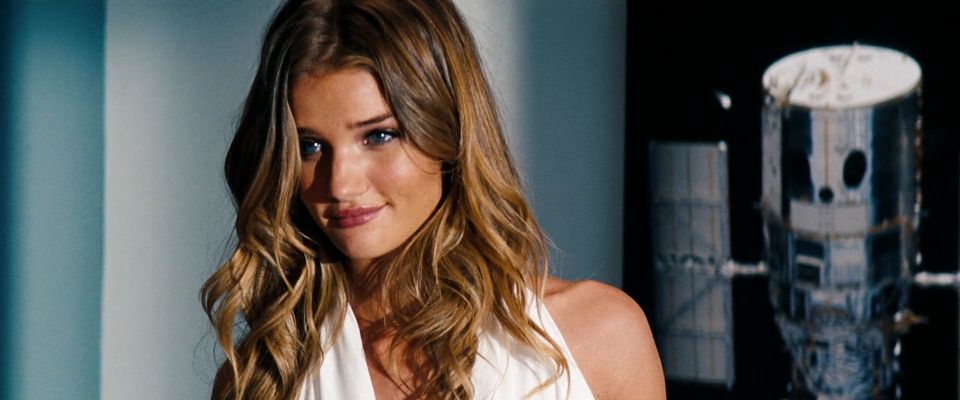 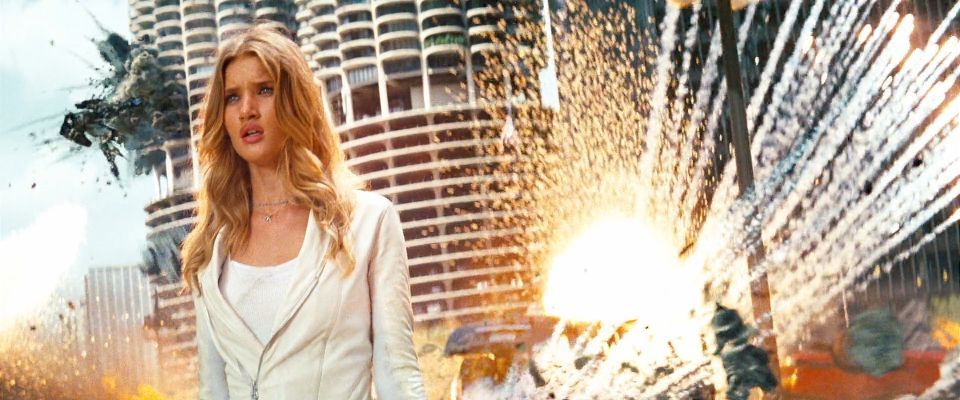 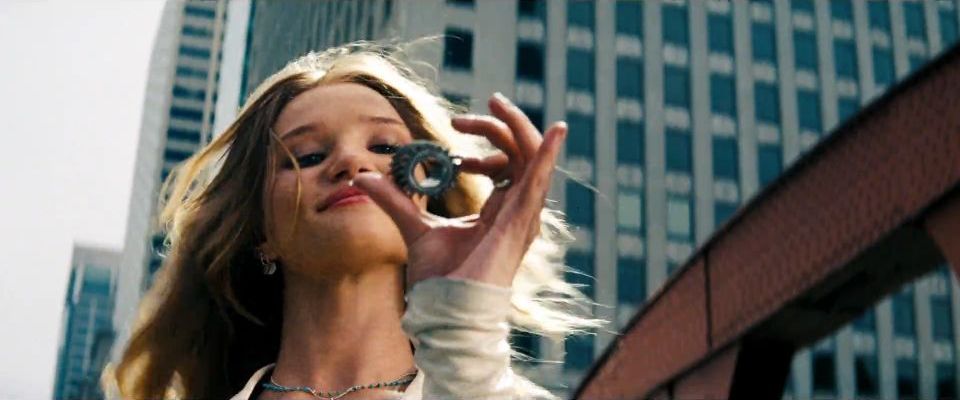 (Music!) (This track has the expected hollywood bombast, and this might just be me making stuff up, but isn't there also something really... sad about it?) In plot terms, Carly is nothing more than another damsel for the main man to obsess over, and most viewers just consider her a half-hearted replacement for Mikaela. However, in spite of having one less movie to her name and getting very little focus even in it, she has not only more character development than Mikaela, but a far stronger arc than every single other character in the trilogy safe one. I just spoke about how the main character of this movie has no control or agency in his life. Really, almost none of the characters in this movie do: Everyone is, willfully or not, a puppet of either Optimus or Sentinel; Every single action or decision made in the trilogy is either by immediate reflex or basically preordained/decided for someone. Here, no one makes the decision for Carly to go and confront Megatron. It’s her who decides to risk her life on an emotional gamble, based on knowledge only she has. The designated “woman” demonstrates agency and self-determination. She walks up to this immense fortress of a creature (the shots of her navigating under and around his massive mechanical legs – gorgeous) and engages with him emotionally. It works on many levels – on one hand, she’s the first person to ever engage the “villain” on actual speaking terms and attempt to see things from his perspective. On the other hand, there’s something delightfully clueless about it all. It’s clear that her picture of him is entirely incomplete, and though she paid more attention to him than anyone else ever did, she totally misinterprets his situation as being about machismo and strength rather than having deeper emotional roots (compare Sam’s story and how affirming his manhood did nothing to alleviate his frustration or depression). Her strategy is rather transparent: Attack him as being a lesser man specifically. Use gendered insults, demonstrate his inferiority, position herself in a controlling position over him as though to say, “here you are, being talked down to by an inferior woman”. Though in the end this strategy is successful (perhaps not for the reasons she thinks) it also demonstrates how totally she has bought into gender roles. Although the very fact that she’s there talking to the big bad of her own volition is a square denial of them, she feels the need to affirm that men should be out there fighting for base dominance and women like her have no choice but to stick behind the lines and lie and manipulate, implying that her talking down to him is an unnatural and undesireable state of things. It’s simultaneously her brightest hour and the start of a horrible downward slope for her character. As soon as the conflict is resolved, the status quo returned and Optimus crowned a god, she quite literally goes “Ooh, shiny things It mirrors Sam’s character resolution, both in its message and in just how anticlimactic it feels. The difference is that with her, it works. Not only is Carly an actually sympathetic character, you actually do get a glimpse of what a great person she could be were she not browbeaten and put in her place by everyone around her at every turn. I stated that she resembles president Obama, but of course, I was semi-joking. It would be more adequate to say that her role is that of pretty much any idealistic upper-class minority person. She clearly intuits that things aren’t quite right as they are, but ultimately is just so irremovably caught up in her prescribed of thinking that in the end she too figures the best solution to their problems is letting a psychotic space god truck run around unchecked. After all, all those other women we’ve seen suffering throughout the series were different people, right? This is precisely what sets her on the path to becoming like the old and cynical Charlotte Mearing, strong of character but ultimately completely powerless. I really wish Carly had received a stronger focus. There’s a lot of material here, but it feels like not even the filmmakers realised just how interesting this could be. It’s strange to say a character needed more breathing room in a series that wastes such massive amounts of time, but there is so much compressed into this last little bit of film, with Carly having to compete for attention with the “climax” of Sam’s character ark, the actual climax of Megatron’s character ark and, well, the conclusion of the whole trilogy, and it’s a fight the creators clearly designed for her to lose. Really, the films’ relationship to feminism is kind of unclear and iffy in general. The female characters are consistently portrayed as stronger, more proactive and more sympathetic than their male counterparts, yet said male compatriots (and even other women!) constantly condescend to and belittle them in sometimes subtle, sometimes unsubtle ways. This is first grader social commentary stuff. But this film also gets a lot more complex than that, showing how women can be totally complicit in their own oppression; Crucially, without actually blaming them for it. But then you look back and see just how much less space and attention they gave to her case, and you start to wonder: Even beyond the dumb butt shot used to introduce her, are the characters really the only ones being condescending here? One gets the unfortunate impression that the creators consider her less worthy of our time than the male lead. Still, Carly makes for a great secondary protagonist. Not to Sam, of course. But to the guy the trilogy is really about.  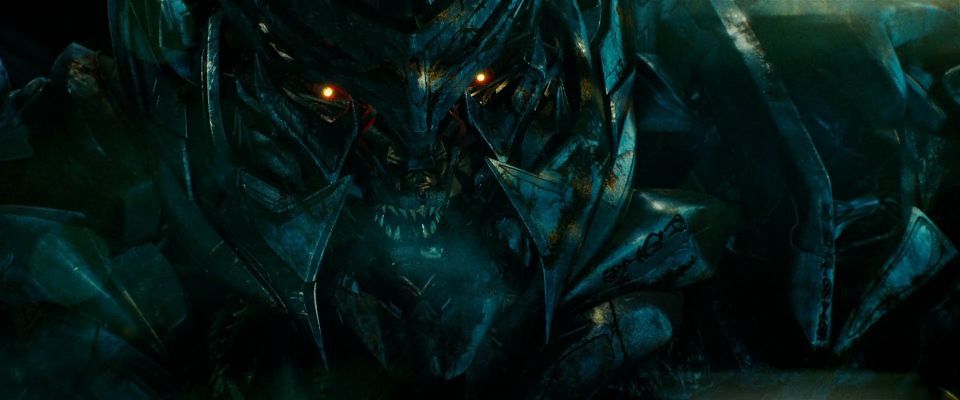  (More music! You may want to listen to this.) Megatron’s last few scenes are probably the best written ones in the entire trilogy, once you see them in context of how he behaved – and was portrayed – throughout the rest of the trilogy. We see Carly brazenly walk up to and insult him to his face. The same Megatron who would previously swat people aside like flies just to express his frustration. Even earlier in this movie, he has a bunch of people murdered, just because. When, at the moment of his victory, some little thing spitefully degrades him, a being with such a total lack of respect or interest in human life would simply continue his swing and crush her like one of his weird head-parasites. But he doesn’t. Megatron lost all his status and power and, yes, his masculinity, becoming a weak and meaningless figure in the eyes of Autobots and Decepticons alike. If being manly was as important to him as Carly thinks, well, there’s a convenient big battle raging on just next door! After all, what’s more masculine than going out to war and killing your enemies? Even in this state he’s still very powerful, so he ought to just go and murder some Autobots, you know, just to show he's still the alpha dog! But he doesn’t. Sentinel Prime has become his enemy again. Actually, he really always was. Megatron surprises, immobilizes and cripples him. That’s really not his style, is it? I mean, Megatron would always destroy his enemies in a single strike, quickly and surgically. Here, Sentinel is at his mercy. He could just rip his head clean off, have his revenge and not have to worry about him getting back to health and returning ever again. But he doesn’t. At the end of it all, he stands face to face with his nemesis, the man who had him killed and crippled and reduced him to nothing. He still has the element of surprise, and his opponent is missing a whole arm. It’s a small chance for him, but it’s a chance at a final victory. Maybe, just maybe, he could finally finish the Autobots, claim the matrix for himself, end the war and save the planet, by felling the one final true threat against him... But he doesn’t. Megatron has been raised by war and hate and murder. He studied the Fallen’s infinite contempt and learned from the crimes and atrocities committed in his name. All his life ever was is fighting and killing... And in the end, losing. For the last several thousand years, every single other living being he met attacked him or degraded him or caused him to suffer. He was taken apart and killed and crippled, physically, mentally and emotionally, spat on and insulted a thousand times. After everything he’s known and experienced and done, at absolute rock bottom, victory sliding from his hands once again, what is left for him to do? It’s so simple, he’s the villain, his actions are practically pre-written for him: Go out in a blaze of glory! Attack all your enemies, coat the city in their blood, spit out your last breath and die a justified death at their hands so they can keep claiming they are just protecting the innocents. But he doesn’t. He gives up. He lets it go. He chooses peace. Whenever this movie is discussed, this scene inevitably comes up, mainly because of how dissonant it is. Why the hell would the filmmakers make this happen? Even though Carly’s words are totally detached from his situation and really make her look more ridiculous than him, they still trigger an epiphany in him. Excuse the image dump, but seriously, look at the animation of Megatron’s face: 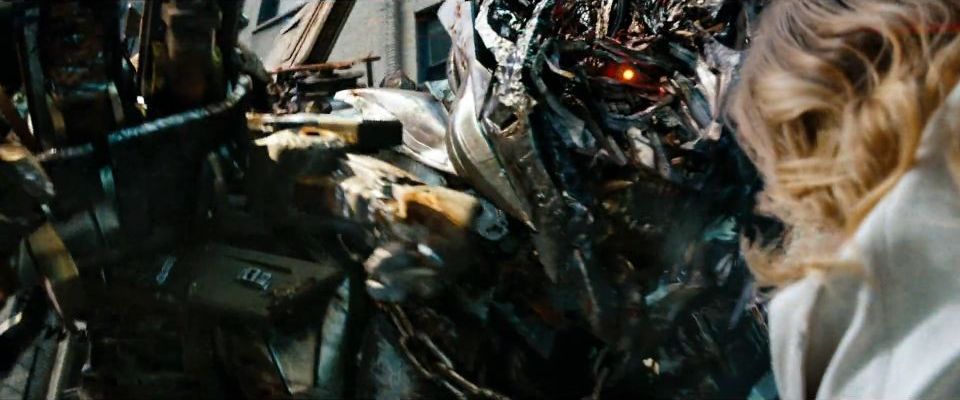 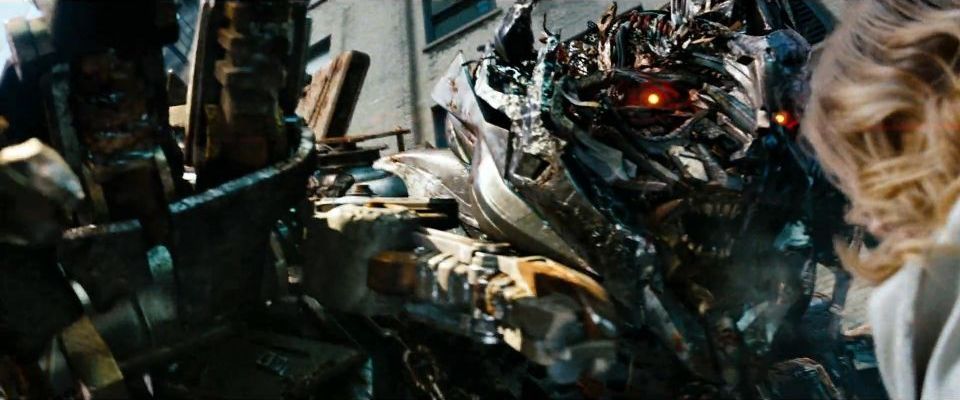 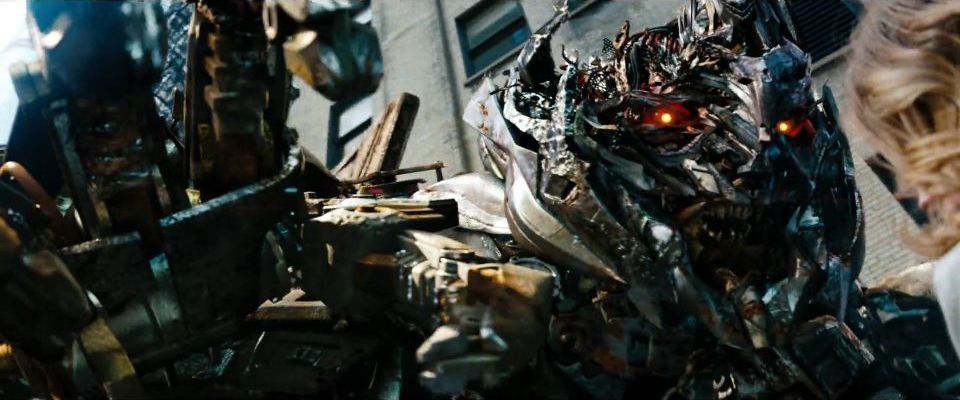 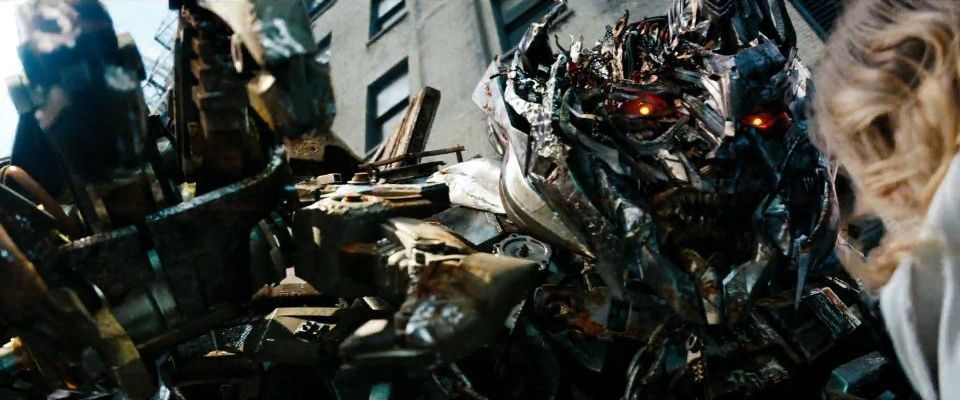 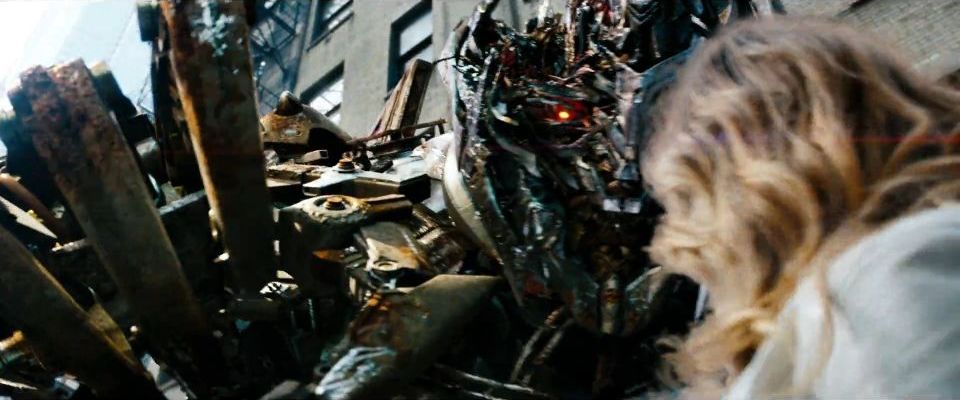 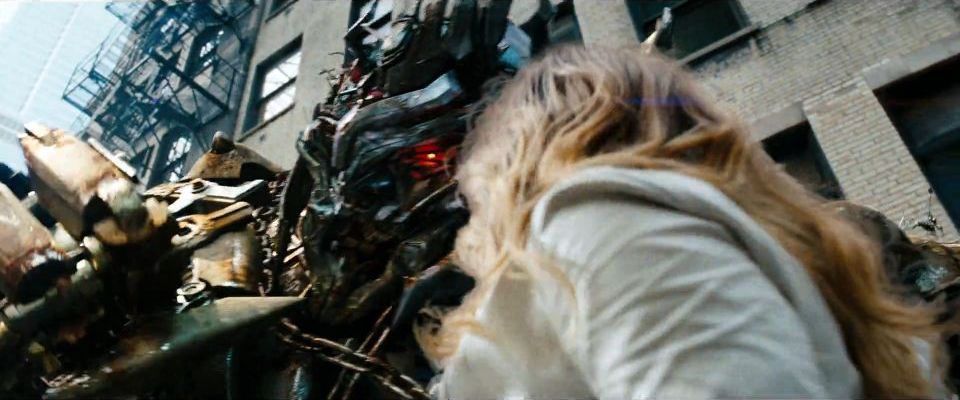 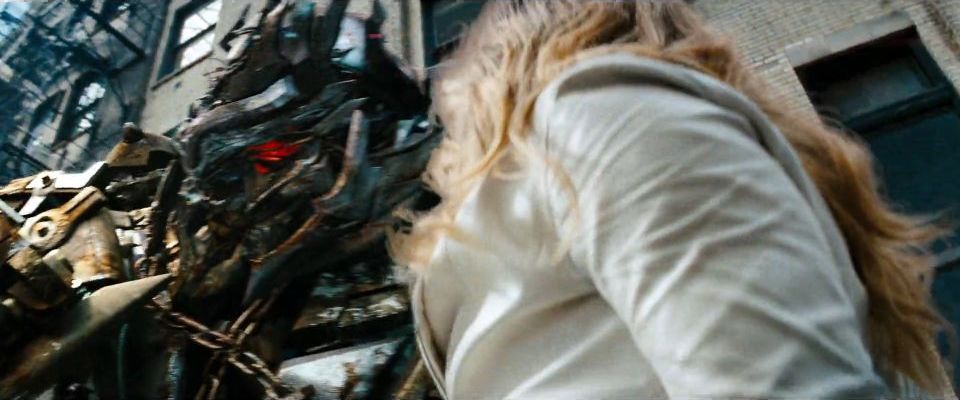 I think there’s a lot more going on here than him not feeling manly enough. Megatron is just so emotive. Throughout the series, facial close-ups of the Transformers are remarkably rare: Even Optimus and Bumblebee get maybe two or three per movie, as the camera usually stays at a bit of a distance, looking up at them. But when movie 3 Megatron is on screen, the camera hangs out on his face constantly. He is cinematographically constructed to be the most human and sympathetic robot (hell, the second-most sympathetic character period) in the film. Pay particular attention to the movement of the eyes: Transformer eyes tend to barely move at all, or too slowly and theatrically. Megatron’s eyes actually move the way human ones would, and the way he repeatedly tenses up and relaxes makes it look like he’s actually breathing. He cripples Sentinel Prime, and, as I mentioned, it’s pretty different from how he tore Jazz in half and ran Optimus through with his cannon. In fact, in a curious contrast to the trademark Autobot facial violence, he makes a point to knock off his helmet.  It’s not a big thing, but without even being seriously harmed or disfigured, Sentinel totally loses his entire authoriative feel, looks weak and old and exposed. Optimus physically imposed a mark of weakness on Megatron by grotesquely scarring him, but what Megs does is reveal an existing weakness, just by taking the guy’s hat off, a bit of a man-behind-the-curtain moment... And of course, it’s the exposed bit Optimus targets when executing him, using Megatron’s own gun. When Megatron asks for a truce, he explicitly offers it in terms advantageous to his enemy, with no posing or tricks. “All I want is to be in charge” – effectively “Yo, I need some time to get the Decepticons back in order because our poo poo is totes wack, I’ll leave you and my, er, alright, your planet alone in the meantime”, and, more importantly, “where would you be without me, Prime?”: Indeed, where would he be without a powerful enemy to demonise and use as propaganda to subjugate the human race? The human people aren’t exactly fond of giant alien robots doing whatever they want and basically taking control of the military, but all he needs to pacify them is a bad guy they can unite against, because that’s an imperative component of any good fascist regime. Optimus’ reaction?  Look at this face. Look at it. This is sheer loving contempt dot jpeg. Just a look of total bald disgust at this ludicrous goddamn idea and the miserable creature that dared to speak it in his presence. He doesn’t even give Megatron’s words a slightest bit of consideration, just covers up his face (!!) and goes into full-on murder mode in three seconds flat. Optimus is always aloof and emotionally distant, but now it’s like Megatron’s unexpected proposal has struck a crack in his demeanour, far more than any weapon could. And that tiny crack is all it takes for us to see the supposed hero of the films tear out the spine of a man who’s unarmed, surrendering and just saved his life. 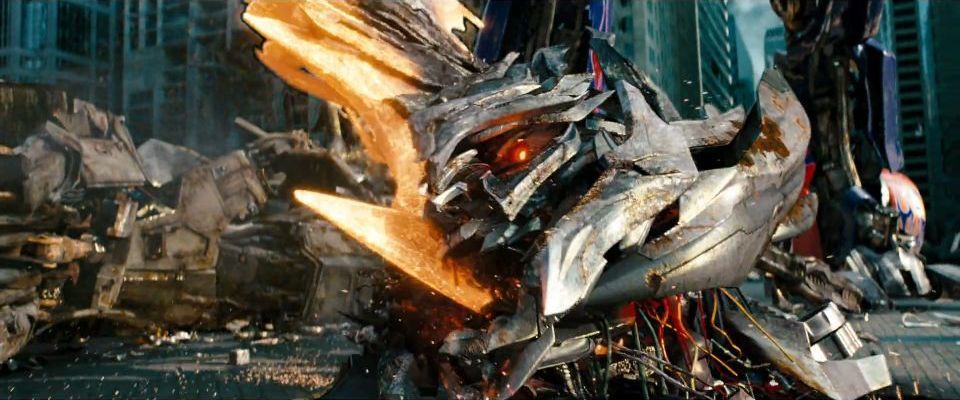 Even in death, he still gets close-up shots. Let’s talk about Megatron in more general terms, such as the way he could be seen as a promethean archetype. We have a Titan who (in this case unwittingly) brought science and technology to mankind, ticked off the Olympians (Optizeus Prime) and was punished by being chained (his character design features literal chains, plus loss of flight etc) to a rock (various Cybertronians refer to the earth itself as a rock, or dirt, or something like that) and being repeatedly killed by an eagle (itself a symbol of freedom, America and so on). Of course, this is very much a heroic archetype. I mean, he’s the underdog. He’s the guy who, even in the circumstances given, is still capable of showing sympathy and mercy. He’s the one who wants to save his species even though most of said species either disrespects or hates him. He just took the first step towards ending a million-year war. He should be the hero of this picture. Why isn’t he? Well, let me put it this way. How would Prometheus react if the very people he brought the fire to locked up and tortured him? Because that’s kinda what happened here. Remember that after this, after seeing them unquestionably serve his nemesis and after being murdered by a human, he’s still capable of treating Carly with some degree courtesy and respect. That, of course, begs the question: What would his relationship with humans be if they didn’t do all that to him? We never get to see his full capacity for compassion because, well, the cards are perpetually stacked against him. Starting with the Fallen’s tutelage: The Fallen, of course, is kind of a dick, and it should be noted that Megatron is at his most callous and aggressive in the film where he’s actually around his master. I’ll remind you of the intro to the film, where the Fallen crushes him underfoot in effigy – I don’t think it’s a stretch to say he’s twisting and suppressing Megatron as a person. (Megatron saying “This is my planet!” recalls Demolishor from the beginning of the previous movie, telling Optimus: “This is not your planet to rule.” He also adds “The Fallen shall rise again” – and here I choose to believe that he’s not just talking about the character rotely called The Fallen, but rather his at that time dead master, who now carries the Constructicons’ legacy. The joke here is that there’s two characters in Revenge of the Fallen who fall and then return to have their revenge – and neither of them is the supposedly titular character.) If I had to summarise the main theme of the trilogy, I would probably do it as thus: It’s a story about how culture and circumstances affect people, or, more specifically, how poor information and understanding thereof inevitably causes you to adapt the worst traits of it. Sam’s total lack of awareness turns him into earth’s biggest dick. Carly nearly manages to escape the web of lies, but ultimately fails and is totally depowered and delegitimized as a result. Megatron spends most of his life as a mad warlord – but at the end, perhaps due to seeing his life deconstructed piece-by-piece before him, he finally receives a sort of epiphany and realises that it’s not just this current situation, it’s his entire life that’s been going horribly wrong. Prometheus is supposed to be humanity’s champion, not its victimizer. Almost every character he references (aside from Khan and G1 Megatron) is considered a defender of the underprivileged. The movies examine in great detail this rift of what he (and Optimus Prime, for that matter) ought to be, and what the reality of his situation has turned him into – and I think he realises this. So he totally changes strategies aaaand... Gets himself murdered again. And that’s that, right? No. You see, the big joke of the movie is that at the end, Megatron wins. He fully accepts his role as a victim rather than a perpetrator, and effectively sacrifices himself for the audience. It provokes Optimus’ crassest and most transparently evil move yet. But wait, remember the last time he did something totally crazy like that? “Give me your face”? That was at the very end of the previous movie. In both cases, right at the climax, just before an absolutely minimal denouement, in conjunction with strong emotional scenes of combat and violence. In other words, The audience’s freshest and most vivid impression of both films will always be Optimus being a huge dick. And it works! I mean, we all like to talk about how audiences uncritically accept these films and don’t really think about the crass stuff within or w/e but the truth is, whenever you see a community outside the likes of reddit or YT comments discuss the movies, even dedicated TF fan communities, what’s the very first thing that comes up? Well, okay, that’s “Michael Bay, tits and explosions”. But the second thing. Well, no, that’s “pissed all over my childhood”. Alright, but the third is “man, those supposed heroes are loving psychopaths.” Those don’t tend to be people with much affection for serious criticism. Remember, these very same fan communities still like to argue there’s no racial component to Skids and Mudflap. But even regular people, even those who love these movies will frequently be left kind of aghast at this ending, even if they just sort of shrug it off afterwards because they aren’t trained to reflect on it. The pretty large cultural pushback against the films is no coincidence. People have clearly identified the films’ “ethos” – that of the stereotypical summer action blockbuster – and are rejecting it. Well, it would be overly optimistic to say they all, or even a majority, are. But it’s still a disproportionally large amount. Read up on some viewer-reviews of the films and compare to, say, your average superhero movie. Even the positive reviews tend to have that oddly spiteful tone to them. Ultimately, this is all exemplified in Optimus’ final monologue: “In any war, there are calms between storms. There will be days when we lose faith. Days when our allies turn against us. But the day will never come, that we forsake this planet, and its people.” He’s sneaky about it, but notice that he’s effectively talking about a state of endless war. He recognises that this victory is temporary, and the fighting will soon begin again – and that he will be there to perpetuate it, completely without regard to the circumstances, forever. But the movie shows us: This is nonsense. An ongoing war can only continue to escalate, and the longer it goes on, the more people begin to realise that something is wrong. And sometimes, it only takes one person (in this case, Carly) to look even slightly beyond the facade to take the first step – we don’t see a miraculous end to a thousand-year-war or mankind rebelling against their new space robot overlords, but considering Megatron’s new outlook and implied immortality, we may have seen the seed that might eventually lead to those things, provided people – both human and cybertronian – pay attention, are willing to challenge their preconceptions, and don’t uncritically accept Optimus’ narrative of endless murder.  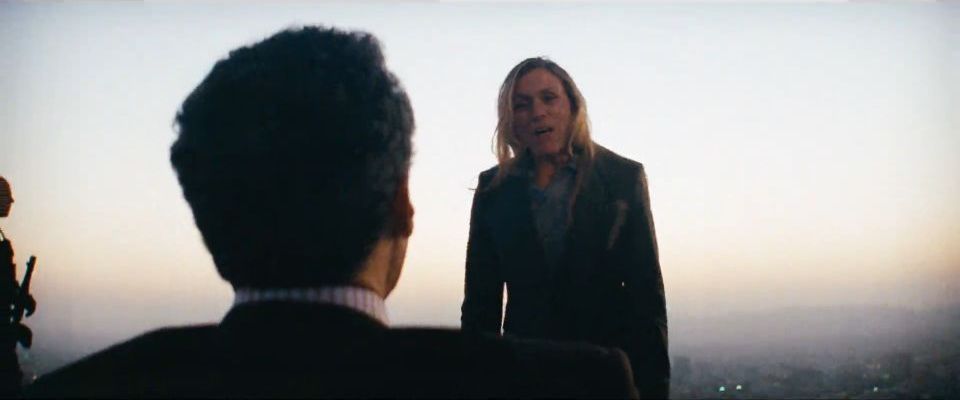 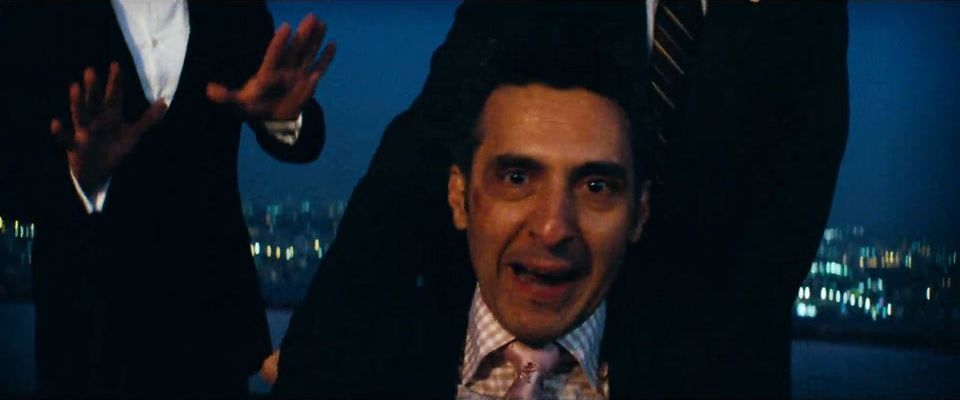 Mid-credits, we are treated to a short scene of Simmons sexually assaulting Mearing with some really crazy lighting. He forcibly kisses her, magically untying her hair – feminizing her, establishing himself as the Man in the picture. If Sam is the “loser” of the trilogy, Simmons is the big “winner”. With his very particular brand of total egotism, he’s one of the only characters to have left the trilogy in a better place than they entered – wheelchair aside – by finding the right niche in the proceedings to huddle in like a rat, denigrating his lessers and hanging onto the big fish. There’s a great skill in how he navigates around the wheelwork of the military-industrial machine that mercilessly crushed so many others. When Mearing orders his arrest, he repeats “take me in!” while laughing and looking at the camera... As if he was sharing a joke with the audience. The joke being? Well, who can truly say. If you ask me: The biggest joke is that right now, on this rooftop, this man can sit and laugh and act, that, even being carted to trial, he is still the most free character out of anyone we met. The joke is this entire scenario, where people like Simmons can succeed and good people like Carly are bound to fail. And that, removed from the person, this line – “just take me in already” – could be seen as a plea to the audience: Do not let this man have his final victory. Transformers presents a ridiculous scenario of earth being taken over by space robots, but space robots don’t exist. People like Simmons do. And do we truly want them to be the winners? ...And with that, the trilogy is over. I'll still have a couple more things to say, however.
|
|
|
|
Terry van Feleday posted:
|
|
|
|
Before this thread came along I'd not given the Transformers movies much thought. But the confrontation between Carly and Megatron, especially the line-reading of "obviously" in response to Carly's query as to whether this was all worth it, immediately stuck out. There was something interesting going on with Megatron and I really wanted to see the parallel universe where the movies were about him. Your analysis is a fantastic expression of the potential inherent in that moment on the tail-end of 7 hours of aggressive, kinetic robots.
|
|
|
|
Perhaps its fitting that the fourth movie of the trilogy plus one (until it makes another billion dollars and puts who knows how many more in production) is called AGE OF EXTINCTION. Because no war is endless, and if people are starting to clue in...well, maybe it's time to end it all. Edit: Another funny detail. In the novelization of the DOTM, the final scene doesn't happen. Megatron says he wants a truce, and Optimus AGREES, and Megatron leaves and that's that. Obviously working off an earlier version of the script, with the final shot version being 'Megatron gets slaughtered'. Even more to think about, that change. Cornwind Evil fucked around with this message at 19:47 on Sep 30, 2013 |
|
|
|
The mid-credits scene is extremely important, because the specific line Turturro drops is (if I recall) "Arrest me! I'd go to jail for love!!" He gleefully, maniacally shouts this straight into the camera, and it seems almost improvised. McDormand is also visibly laughing in the background, but it's a genuine laugh, as though she's broken character. The quality of the footage seems lower than expected too, as though this were a behind-the-scenes clip or something. But anyways, the point is this idea of willingly 'going to jail for love' in a film that's all about varying concepts of freedom. The climactic line for Sam's character is "I'm just the messenger" which is an odd one. It's superficially badass, like he's a prophet of god and that power courses through him or something. But of course, the god in question is the face-stealing Optimus Prime. And here's the kicker: Sam insisted earlier, during one of his entitlement hissy-fits, that he only takes orders from Optimus. So what has changed? He really hasn't learned anything! Sam has only stopped trying to impress his fellow humans. Although she's not present, this line is 'actually' directed against Mearing and her insistence on following a chain of command. Being the Autobots' messenger afforded Sam no rank in America, but this is Optimus' planet now. Why change yourself, when you can simply destroy the world? When Optimus swoops in at the end of the toppling skyscraper sequence, he bellows something like "I'M HERE FOR YOU", and it's actually a very ambiguous line. It's unclear if he's talking about saving the heroes or just slaughtering Shockwave, but the effect is that it means both - that preserving 'humanity' can only occur by expunging the 'inhuman' monster. We've already established how Megatron is the genuine leader of the Deceptions because he cares for the weakest, is the weakest. When Sentinel shoves his hand into Meg's head wound, his failure as leader is obvious. So there's a beauty to the Megatron POV shot (!!) where he gazes up at Cybertron. Importantly, there is no such POV shot for Optimus - or for any of the protagonists, really. Megatron dreams of a world where even the little deformed green homunculus he feeds is treated well. Not only treated well, but elevated to the highest rank! Sentinel goes on about how sacrifices had to be made, how people had to be betrayed for the greater good, but this is what Megatron specifically refuses to do. See, the crucial nuance in Carly's interaction with Megatron is that Meg doesn't actually mind being a 'bitch'. Megatron, in all his abjection, is king bitch. The part he objects to is being Sentinel's bitch - compromising his idealism out of 'pragmatic necessity'. Where Sentinel talks about how "the needs of the many outweigh the needs of the few", and Optimus believes in the needs of 'all' (to the implicit exclusion of the 'non-all' remainder), Meg loves his fellow abject 'bitches' above all else. Only Megatron is motivated by this sort of authentic, uncompromising love for his neighbor. (Y'know, like Jesus!) And that brings things back to the mid-credits scene, where the literal plot content is a exaggeratedly romanticized sexual assault by a broken man, but the form is of two Coen Brothers stars expressing a wholly unironic camaraderie. Turturro's sincere belief in a mad, unconditional love worth sacrificing oneself for shines out from under the Simmons character's weird odiousness. And really, that's the story of the film. Most of the characters are motivated by a love (of their families, of America, of 'humanity', etc.) that is genuine but overly particular and exclusionary. Not Meg, though. There's a theme in the film, that Terry already pointed out, of Autobots flying in to provide an obscenely happy interruption of some inevitable doom. The flipside of this is Que's detestably over-sentimentalized death, which stands as a stark contrast to Megatron's end. There's no sentimentality, as with Bumblebee's over-wide ET eyes. But it's also not callously ignored, like the deaths of Brains and Wheelie (this film's version of the twins - tolerated by the 'multicultural' heroes, but ultimately disposable). Megatron simply dies for the little guy, without pleading, and it's the only dignified end in the series. Though Optimus fronts about universal freedom, Megatron remains pure to the last. SuperMechagodzilla fucked around with this message at 04:53 on Oct 1, 2013 |
|
|
I'm pretty sure there's something to be said about how Optimus tries to beg for his life when Sentinel stabs him (since it's so unusual for him to display anything except anger and murderous rage), but my brain's been sitting for too long. Time to watch this film again! 
Milkfred E. Moore fucked around with this message at 02:50 on Oct 1, 2013 |
|
|
|
|
So I followed the original thread, and now this one. I have never seen the films, minus the screenshots that Terry posted, and the 15 min ending sequence that her poor laptop put on Vimeo. Should I walk away now and not watch? I was amazed at how even in that visual blur, there was in fact true emotion displayed. I mean, just in a voice over, that is some of Leonard Nimoy's best acting for me and I have been watching him since like 1980. So as an early wrap, thank you Terry van Feleday for your insight and effort. This is probably in my list of top 5 threads I have followed on SA.
|
|
|
|
Terry van Feleday posted:
After the examination of the 9/11 imagery in the film, I'm surprised you missed this. It's looks like a reference to the charred remains of two Blackwater contractors being hung from a bridge in Fallujah, which was an impetus for the two attempts to recapture the city in 2004. I'd could also say it's also how Mussolini's body was strung up for display, upside-down and arms hanging, after he was disposed of by anti-Fascists. Fallujah was more recent, and I believe in some of those the photos you can see the mob stringing them up (or cutting them down, depending on the context of when the photos where shot).
|
|
|
|
SuperMechagodzilla posted:
Isn't this excessively laudatory since Megatron spent most of the film conspiring with Sentinel to enslave humanity, even referring to Carly explicitly as slave? Not to mention his complicity with the terror attacks against the civilians in Chicago. Isn't that a sacrifice for the greater good? Except Sentinel defines greater by numbers and rank, while Megatron chooses the greater good of a moral category of personhood. It's like in the Pacific Rim thread when you characterised Mothra's destruction of a city as a defense/assertion of christian morality IIRC. We're there innocents in that city Mothra destroyed? What about in Chicago? In both cases you fail to address the underlying pathology of an 'overly particular' and destructive action for the sake of supposed universalist ideals. So why should supposedly egalitarian love inflict the pain and degradation of slavery, terror and death on humans? Here I'll invoke the idea of ressentiment as an explanation for Megatron's actions. ”The ressentiment which results from want of character can never understand that eminent distinction really is distinction. Neither does it understand itself by recognizing distinction negatively (as in the case of ostracism) but wants to drag it down, wants to belittle it so that it really ceases to be distinguished. And ressentiment not only defends itself against all existing forms of distinction but against that which is still to come. …. The ressentiment which is establishing itself is the process of leveling...It must be obvious to everyone that the profound significance of the leveling process lies in the fact that it means the predominance of the category ‘generation’ over the category ‘individuality’.” -Kierkegaard Remember that Megatron lead a slave revolt against the aristocratic, godlike Primes. Sentinel says “We were gods once...All of us!” but he means only the Primes. Megatron lead a slave revolt of morality against exactly this specific privilege. But he didn't aim to level all others upwards to a level with Primes. He wanted to establish abjection as the state of normality and then morally (but not socially) elevate the formerly littlest ones to the highest ranking. To do this he must belittle and drag everyone else down into abjection. Even if it means enslaving humanity for the sake of the wretched Cybertronians, that's permissable for Megatron because it is the universalisation of the status of the littlest ones. To Megatron, no distinction is acceptable if it exceeds that of the wretched. So why does he insist on being in charge, after he has removed Sentinel from his former place and status? “...picture 'the enemy' as the man of ressentiment conceives him—and here precisely is his deed, his creation: he has conceived 'the evil enemy,' 'the Evil One,' and this in fact is his basic concept, from which he then evolves, as an afterthought and pendant, a 'good one'—himself!” -Nietzsce You're right that Megatron doesn't mind being a bitch. The degradation he suffers only intensifies his identification with abjection through the series. He goes from acting from a sense of mission to acting from a sense of personalised identity. In fact he comes to identify so totally with abjection that as Terry pointed out in the previous thread, he wants to be a unifying symbol for his people, an avatar of abjection, or as you put it, 'King Bitch'. This is why he says “I just want to be in charge”, even though it means replacing the Primes and reducing all others to a levelled state of abjection. If Megatron rules, there is a rule by proxy of the abject and wretched who are now are an example of the supreme moral standard, and the inversion of moral value against the class of Primes is completed. If we're going to continue the Christ analogy, then we view Megatron best as a Christ who differs from the religious figure by the fact that he gave into temptation while being tempted early in the film during his time in the archetypal desert by Sentinel (filling in for Satan, he even has a somewhat demonic appearance). Megatron is provoked by Carly's accusation of bitchood not because he doesn't see himself as a bitch but because he realises he has failed in his goal of revolt of moral inversion against the Primes by allowing Sentinel to reestablish every Deception as his personal bitch. Megatron is a Jesus figure who wants to bring the lepers and outcasts into the community but lacks the sole power to heal them first (denied to him in previous films), so instead he transforms (lol) by terror and violence everyone else, innocent and guilty alike, to extinguish all differences of moral category of personhood and prevent rejection by the community (Earth). Note how Megatron gives no indication of concern for the status of humans as bitches and slaves. To him, that is their proper levelled place at the conclusion of a slave revolt in morality- they belong among the wretched now. Megatron's initiative of an attack on Sentinel is motivated to prevent someone like Sentinel from towering (figuratively and literally, he does both for a while and casts out Megs from the same status, denying even the illusion of equality) above and having slaves and bitches. To Megatron, if anyone is a bitch or slave then everyone should now be a bitch or slave. It's like a dastardly re-interpretation of Eugene Debs- “If there is a soul in prison, then I am not free...so gently caress it just throw everyone in there...”. SuperMechagodzilla posted:But anyways, the point is this idea of willingly 'going to jail for love' in a film that's all about varying concepts of freedom. So, having being saved from the planetary imprisonment and involuntary subjection to Megatron's bizarro-christian love for the wretched, Turturro's character is providing ironic commentary on his, in this case, willing subjection to the autobot's oppressive and manipulative brand of love for humanity. It seems like a “He loved Big Brother” type of moment. In the Pacific Rim thread you argued that the jaeger pilots should have aligned with the abject kaiju against the alien and human overlords for the sake of universalist egalitarian solidarity against oppression. You're using very similar rhetoric here, but Megatron doesn't fit your characterisation. Critically, Megatron failed to align with the humans against their Autobot oppressors because he overlooks the contradiction between on the one hand, protecting and morally elevating the Deception wretched, and on the other hand, the necessity to his plans of reducing humanity to the wretchedness of abject slavery. And by not doing so he alienates humanity into the oppression of a perpetual war machine which will only destroy the things he wishes to protect. Fake Edit: Kinda venting in this post because I read SMG's posts in the Pacific Rim thread but can't address his reading except in a film I actually want to watch or a similar one I have already seen. Corsec fucked around with this message at 08:08 on Oct 1, 2013 |
|
|
|
Sam murdering Dylan with a club is a really wicked way to make sure the players in the film don't get to interrogate him for all his juicy info on what the Decepticons plans were and whatnot. He says to Carly that he only needs another 40 years, which seems insanely selfish until the end. In a film this rich with religious imagery, 40 years of time for humanity takes on new meaning. Jumping back a film(watched a few more of the clips on Terry's Vimeo), right before Optimus maims Megatron and removes the face of the Fallen we get that scene with Jetfire sacrificing his parts. There's a body horror element to it that's disconcerting, pushing the transformer aliens further away from the humanoid shapes they wear and into something closer to one of Lovecraft's shoggoths. These just happen to be made of metal instead of meat. However, it's the proximity to the climactic fight/execution scene that's got me thinking. Jetfire grossly rips out the metal alien version of a heart to give to Optimus and says, "Take my parts and you will have a power that you've never known. Fulfill your destiny". I had forgotten that in addition to the face removal, he punches his fist through Fallen's chest grasping his still glowing heart. "I rise, you fall" Cut to Megatrong and Starscream looking on in abject horror. Starscream urges survival, but Megatron is still in shock. "This is no Prime." No poo poo. A large chunk of his head may be gone, but Megatron might be the first character to comment on the wrongness of his enemy's name/title. They turn and leave the profanity before them. The audience has been spared another round of Optimus consuming a sentient being, this time an unwilling one. He sheds Jetfire's external parts in disgust once they're no longer needed, but seems to keep the hearts. Bay does not gently caress around. edit. They're a lot more like pod people than I remember too. Metal pod people. Maarak fucked around with this message at 07:57 on Oct 1, 2013 |
|
|
|
Corsec posted:Isn't this excessively laudatory since Megatron spent most of the film conspiring with Sentinel to enslave humanity, even referring to Carly explicitly as slave? Not to mention his complicity with the terror attacks against the civilians in Chicago. Isn't that a sacrifice for the greater good? Except Sentinel defines greater by numbers and rank, while Megatron chooses the greater good of a moral category of personhood. Megatron is a flawed character with an arc: originally believing that resurrecting Sentinel is necessary to save the children, he has an epiphany. He called Carly 'slave', but then refrains from killing her. The decision to spare her is the key point there. The slavery plan is Sentinel's bullshit - Sentinel is all about being a god and master over humanity. What we see is Megatron's realization that if Carly is a slave, then so is he - so is everyone. He doesn't attack Sentinel to prove his masculinity, but to redeem himself. The world of transformers is fraught with objective violence. The film begins with Optimus in charge of the Autobots, going on covert, unauthorized missions. They talk about how peaceful it is, but we see surveillance devices and armed guards everywhere. But, beyond that, the whole of society is hosed if Malkovich's character is a respected billionaire. Megatron fights against this horrible state of affairs, and characterizing that as 'dragging everyone down with him' is unfair.
|
|
|
|
First of all, When you consider the violence the Bay Autobots commit on their fellow Transformers from their perspective, it's grotesque, and absolutely psychotic. As far as I know, the other iterations of these robots-in-disguise have never been so gleefully barbaric. For example, the most recent Transformers game, Fall of Cybertron, we see an Optimus Prime who, in many ways, resembles Bay's Megatron. All he wants is to ensure that his species can live on, but his opponent craves nothing more than eternal war and domination. We see this idealogy with all of the Autobots, (who are actually pretty sympathetic here, go figure), and it's something that's even reflected in their random dialogue. When a Decepticon character kills a random Autobot mook, they celebrate and taunt the deceased. When Optimus Prime does it, his call-outs are reflective spots of remorse, things like, "Regrettable, but necessary." In fact, if you check the IMDB page for Optimus Prime, nearly all of his quotes are oriented around that sort of thing: http://www.imdb.com/character/ch0003342/quotes Optimus Prime is a gentle soul who will answer the call to action if necessary. Above all else he values friendship and freedom. Bay's Optimus is a stone-cold mothafuckin' killer.
|
|
|
|
Sorry, I edited my post a few minutes before you replied. It's the second quote of you plus the paragraph afterwards. I think that there isn't any textual evidence that Megatron's epiphany from Carly's goading is from recognition of her personhood. Quite the contrary. Carly's goading doesn't even reference herself directly or the degredation of her treatment. She has been coded as a bitch, possession and trophy then taunted with slavery by Megatron, and nothing from Megatron gives any challenge or refutation of that either before or after her goading. This is a character who has treated human lives consistently with moral disregard. He comes to a realisation, emotes, then leaves. She's not even worth talking to any further, or explaining himself to. Implicitly she's still viewed as an insect by Megatron. As to the content of his epiphany, rather than addressing the humans in any meaningful way, especially Carly, he goes straight to Sentinel and Optimus. I've already discussed why he repudiates his association with Sentinel...Sentinel's thing is about being a god and master not of the humans but of the transformer underclass. Megatron wants to make sure someone like Sentinel never makes slaves and bitches of transformers, specifically. He's reminded that if Sentinel treats Megatron like a slave, he'll treat all remaining transformers like slave, especially Megatron's little children. It's hard to imagine Sentinel even noticing the humans under different circumstances. Megatron doesn't even notice humans after his epiphany, in the middle of a battlefield full of them. It's worth remembering that Megatron was once up there, on the tower beside Sentinel, till his pathetic begging for equalilty and partnership provoked Sentinel to drive him away in a brutal and humiliating reassertion of his old status in front of Megatron's followers. Remember that the terms of the truce Megatron offers condemns humans to the exact continuation of the objective violence you've identified as part of the autobot system. Who could be more aware of the nature of this system than Megatron? Does Megatron use the chance to barter for better treatment for Carly and the oppressed on Earth? In fact, as Terry points out, he even implies that his own leadership on nearby and not-yet-destroyed Cybertron will give Optimus the "powerful enemy to demonise and use as propaganda to subjugate the human race". So where in that is your fighter against this 'horrible state of affairs' on Earth if he is complicit in it's further intensification? Again, I'm co-opting your off-thread rhetoric about how the jaeger pilots should have allied with the kaiju against all oppressors. So if Megatron is fighing against objective violence, why did he fail to ally with the humans, expressing solidarity with Carly and the misguided soldiers, rather than going straight to make a deal with Optimus Prime? Corsec fucked around with this message at 10:36 on Oct 1, 2013 |
|
|
|
I would be very careful calling Megatron a Christ figure, because that implies divine grace and perfection. He's very much more of an Anakin Skywalker, who is of course himself a Christ figure, but with some important differences - when he (symbolically) dies and is revived, he initially comes back a worse person, not one who has proven his divinity, for example. The reason this distinction is important because although both Megatron and Anakin want to be good people and seek guidance through love and so on and so forth, their fears and attachments, coupled with the total lack of a proper support network and a tendency to rush ahead without always thinking about the consequences of their actions, keep guiding them off the right path and into illicit hands. Perhaps you could see it as the correct choice to go patch things up with the humans directly, but that's not how Megatron operates. Carly's implied request is much more immediate: "Go stop Sentinel". Everything else can wait. I think it's a sign of his degree of understanding that he complies immediately, and, and this is the important part, saves his mortal foe. It's an action with much, much more symbolic weight than merely laying down his arms. It seems like a questionable decision to save Optimus, who we'd all agree would be better off dead, but it shows his willingness to love his enemy. It's the most immediate and powerful statement he could make in that situation - remember that at this point he's basically destroying any chance of the slavery plan being successful (since Sentinel is the only guy who knows how to use the space bridge, and Optimus is the guy with the best chances of stopping it). I would further argue that had Optimus not acted as outrageously and just murdered him, it would have given him a good initial footing for further diplomacy, since I doubt people would be particularly interested in hearing out the guy who wanted to enslave them before. Slavery is not on the table at this point. It's also important to note that humanity is not portrayed as a cohesive entity whose collective interest is under question. Women are dogs and slaves already, and so are black people and so on, so most of humanity actually has very little to lose. But remember also that Sam's entire character exists to show how the privileged suffer from their own privilege. Jesus wanted the rich to save themselves by giving away their possessions, Megatron may or may not be that patient. Ultimately, we can have an entirely justified argument over whether his ideology is just (after all, that's an argument that's been going since at least the birth of the soviet union), but that's an external judgement we make as viewers. The film itself is pretty clear about whose side it's on.
|
|
|
|
A quick recap on Megatron: Megatron sent himself on a lonely thousand-year mission to retrieve the allspark and save his planet, after the mad Optimus Prime destroyed Cybertron by launching its best/only energy source into space. Prime had effectively starved the entire planet to death in the name of an American-style freedom supported by a few hereditary god-king types. But anyway, at the cusp of saving his planet, Megatron suffered a terrible accident and was frozen alive for hundreds of years. When finally discovered, he was not helped but slowly vivisected by the humans. His exploited flesh became fodder for the industrial revolution. From then on, his only goal had been to help his people, with Optimus manipulating the humans into demonizing and exterminating them. Megatron isn't a Jesus figure, but he isn't a Darth Vader/Bane figure either. We all know that Vader has an unwavering ethical commitment to the 'dark side', but then renounces it all and removes his mask out of particular love for his son. Meg 'puts his mask back on' after realizing that he himself had been 'all too human' and lost track of what he was supposed to be doing. IMAGERY: the final executions take place on a bridge, and of course the whole plot centers around a 'space bridge'. It's about the future of the planet, the transition from one state to another. When Megatron volunteers to help Optimus and is killed, this is extremely symbolic - because what is Optimus about more than 'protecting humanity'? Carly has obviously convinced Meg that the humans are not his true enemy. Megatron has decided to let them to join the Decepticons - not as prisoners and slaves but as equals. The only catch is that Optimus cannot be the leader, for obvious reasons. Killing Megatron on the bridge is Optimus' statement that nothing will change. It was never about protecting humanity. It was about dominating.
|
|
|
|
SuperMechagodzilla posted:A quick recap on Megatron: So, what you're saying is, the Michael Bay computer toys movie has the following elements: - a character with Jesus-like love for the abject - superficial multiculturalism that's actually exclusionary - a conflict of specific love vs. universal love - allusions to Marxism - persecution of the "inhuman"
|
|
|
|
This is the best loving forum. EDIT: Based on the analysis in this thread, I would put the Transformers movies in the same category as 300: Movies that simultaneously are propaganda but also reveal themselves as in universe propaganda.
|
|
|
|
So Bay is a Paul Verhoven who doesn't know he's Paul Verhoven? This threads are amazing. They need to be saved or posted in a way that's accessible to everyone. They need to be spread.
|
|
|
|
|
Count Chocula posted:So Bay is a Paul Verhoven who doesn't know he's Paul Verhoven? Bay is just Bay, doing what he does best consistently and intelligently since Bad Boys. The fact that he's not as overtly (ham-handedly) satirical as Verhoeven doesn't mean he, like, lucked into his entire filmography.
|
|
|
|
I think that Megatron's intentions towards humans in particular are really important for understanding his values/motivations in this film. Megatron's act of destroying the statue of Lincoln and replacing it with himself is an example of his ressentiment thinking. By destroying/displacing/usurping the place of a symbol of the rejection of slavery and assertion of freedom, Megatron isn't merely signalling the re-emergence of literal historical slavery but is symbolically engaging in inversion of value. As well as placing himself, and abjection by proxy, as the object of reverence, he is also asserting the non-contradiction between a new literal slavery and it's goals of service to the abject. His ressentiment collapses following his rejection by Sentinel because while slavery is still a viable plan with Sentinel's now-sole leadership, it is now no longer possible to establish a completed inversion of moral values within and above society. It is therefore Sentinel who destabilizes Megatron's ability to ignore the cognitive dissonance generated by the contradiction between his actions and his convictions, not his encounter with Carly. All Megatron's internal conflicts have been therefore been established when Carly forces him to fully confront them and goads him into resolving them. Carly doesn't provide a new source of internal conflict for Megatron, she is the catalyst to his internal conflict and proves that continued inaction is inconsistent with his moral convictions. I agree that Megatron then turns away from ressentiment, finds himself 'all too human', and then rejects his previous plans to fight oppression through establishing a justified oppression. I'd disagree there is textual evidence that he has committed himself to any postitive ethical duties to humanity, for reasons stated in my previous post and because Carly forces Megatron to look inwards, not outwards at her and her own status/treatment. While his attempt to reach a truce with Prime would have opened a better space for that to happen, I see little evidence for his interest in positive duty other than what stems from his attachment to and identification with the abject. Before his death he has only went so far as (possibly temporarily) respecting the negative liberty of freedom from slavery for humans, and was motivated to do so to protect his own people from slavery and detestable morality/values. Corsec fucked around with this message at 16:19 on Oct 2, 2013 |
|
|
|
Snowman_McK posted:This is the best loving forum. Are there ways in which 300 is "in universe propaganda" for reasons other than the ones that make people familiar with the history cringe but would make sense in a "Spartans are the most badass guys ever." context? Since if there are, I'd actually really love to hear them. By the way I mean stuff like calling Athenians "boy-lovers" when they had their own agoge (institutionalized boy-loving), most of the allies conspicuously going missing, breaking formation and engaging in single combat when that'd be a terrible idea for a phalanx, fighting ninjas and alchemists and giant mutants and so on. Oh, and Xerxes actually being wounded.
|
|
|
|
Chucat posted:Are there ways in which 300 is "in universe propaganda" for reasons other than the ones that make people familiar with the history cringe but would make sense in a "Spartans are the most badass guys ever." context? Since if there are, I'd actually really love to hear them. The story of the film is framed as the only survivor of the 300 telling it on the eve of battle to raise the morale of the troops. verybad fucked around with this message at 09:40 on Oct 3, 2013 |
|
|
|
verybad posted:The story is framed as the only survivor of the 300 telling their story on the eve of battle to raise the morale of the troops. A survivor who very explicitly wasn't anywhere near the final battle when it took place. Or any of the court scenes. Or the creeper temple.
|
|
|
|
verybad posted:The story of the film is framed as the only survivor of the 300 telling it on the eve of battle to raise the morale of the troops. Yeah I remember that part as well, which is what justified all the stuff I mentioned in my previous post, since he was just blatantly exaggerating so they'd feel even better about fighting weaker, crappier Persians who didn't have giant crab men with them.
|
|
|
|
Now, before I conclude this whole deal, I want to address one of the more interesting questions about the films: Why are all these robots so drat ugly?? I feel one of the most misunderstood aspects of the films is their design language. Most people, including people who make tie-ins or fan art or frequently even the toys, seem to believe that the aesthetic of the Transformers begins and ends at MAXIMUM GREEBLIES. This is a sad disservice to the creative work of the designers, and has a lot to do with how we perceive visuals.  Looking at an image like this, I can totally forgive your eyes glazing over and developing a startling desire to just look at something else for a minute. Simply put, it’s a mess. The proportions are wack, no visual detail meaningfully flows into another, the colour balance and individual contrasts would probably get you thrown out of art school. And of course, this being his actual CGI model, this is a pretty good representation of what he looks like in the movie, right? Well, no. We tend to think of “character designs” as a defined appearance carrying the character visually, effectively something the character “is”. This idea seems so self-evident I’m not even sure how to describe it without resorting to tautology, but it shows severe flaws in ignoring the differing role and task of our eyes in perceiving a similar construct in differing contexts. To try and explain what I mean, I’ll have to get into what necessitated this kind of design language in the first place. Transformers (2007) presented a demand for special effects on an unprecedented scale, which presented a number of massive challenges for the entire crew, and particularly, of course, the animators. Beyond the obvious difficulties, there was also the very specific demand of having a number of scenes in bright daylight – a problem that ILM VFX supervisor Scott Farrar touches on in this lil’ video, explaining that of course, the usual preference is to keep the models out of light and out of focus so you don’t get to immediately see their flaws. That not being an option, the creators had to find different ways to make the effects not look fake. A constant undercurrent in the first film’s construction is a general sense of insecurity. The team clearly wasn’t sure about how their work would look in the end, and they cut a lot of corners to ensure everything would look and behave smoothly, like only implying that Megatron has wings with the cinematography because ones actually on his back could get in the way of the action. The movie still spends much more time at night than the subsequent ones, and the Transformers spend very little time in the very centre of the screen, usually hanging out around the edges. In fact, one of my favourite bits of trivia about the first film is that it uses practical effects wherever possible. Beyond using a unique CGI/miniature hybrid approach for some scenes, they also built physical props for parts of Skorponok, Frenzy, and, indeed, a full-scale Bumblebee for the scenes in which he wouldn’t have to move. 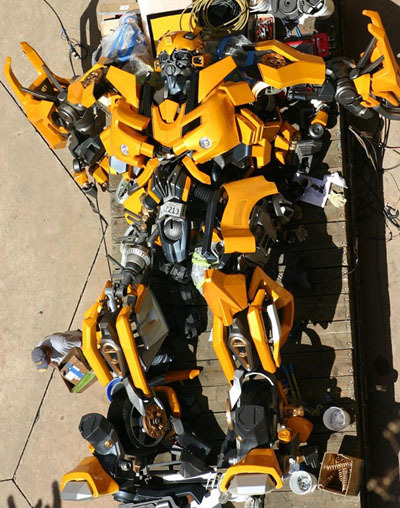 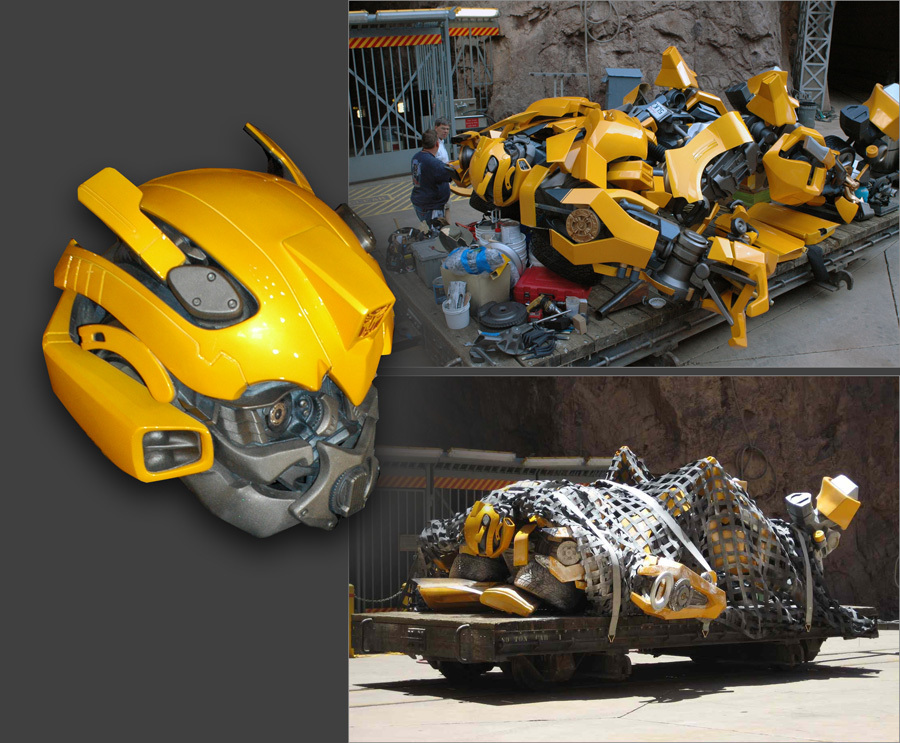 One of the big worries that must have come up in the actual design stage is that they had to avoid flat surfaces wherever possible. Making a simple, flat design like your average G1 Transformer look good as a CGI projection in a live-action context is near impossible because unless you expend obscene effort to get all the reflections and little textures just right, it’s always going to look, well, flat, and artificial. The sheer amounts of visual detail on the Transformers fulfils the dual purpose of a) breaking up the surfaces to slightly ease the work of the animators, and b) in conjunction with the framing choices of the film, they actively prevent the human eye from properly focusing on the things, which itself both more effective at “hiding the effect” than just keeping them in shadows and only showing them for seconds at a time. It also has a different, much more important purpose that goes back to filmmaking as a craft in general. 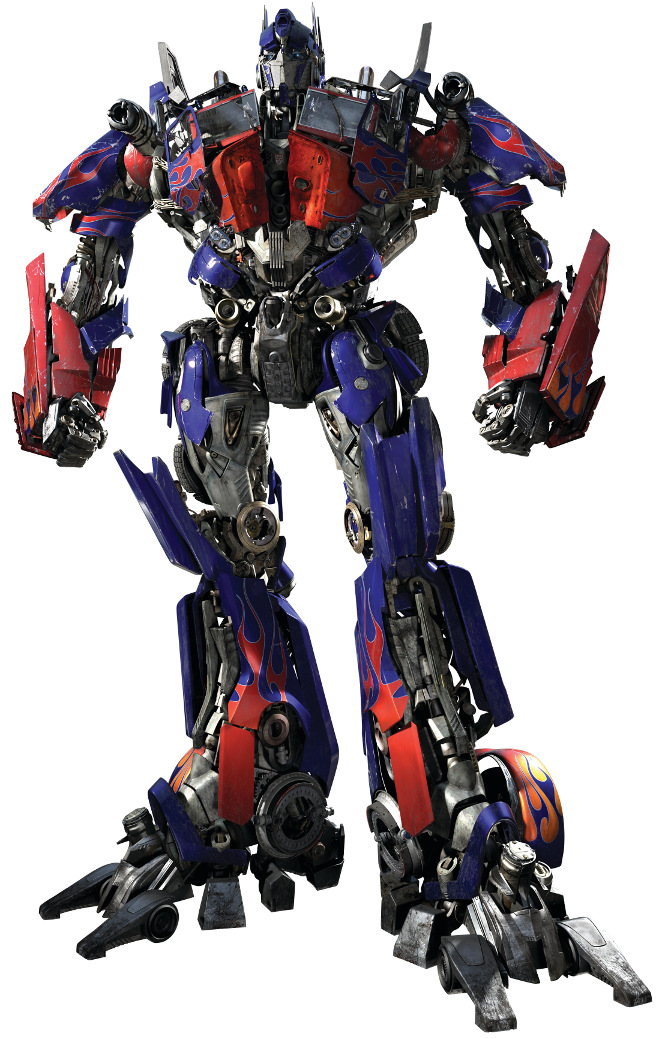 Check out this render of Optimus as he appears in the first film. What do you see? A large amount of mechanical junk, for one. But remember, that’s not what you see in the actual film. What you actually see is something more like this: 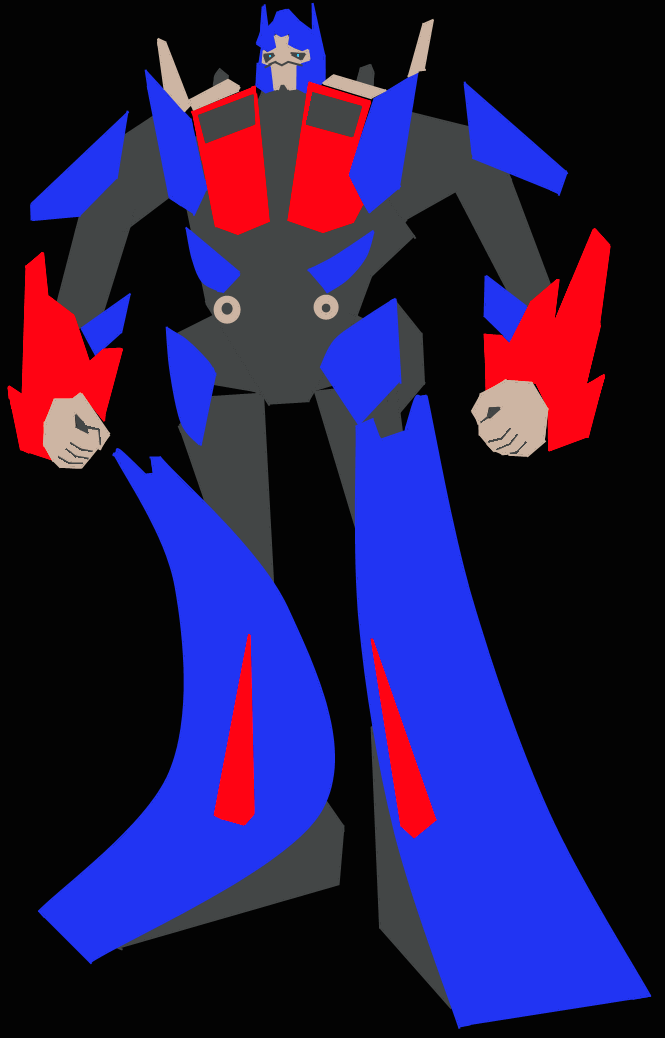 We have neither the opportunity nor a particular motivation to focus on all the details in the actual film context. What we do see in those split seconds of divided focus are, however, the imperative parts: The overall shape and lines of the design, what people in the artist’s trade call “gesture” or “figure” or “form” or like a million other things. If you haven’t heard of “gesture drawing”, it’s an exercise in which the artist attempts to capture the fundamental motion and attitude of their model in as few lines and details as possible, forgetting about the physical and visual details entirely to attain something much more fundamentally lifelike.  A random example I plucked from GIS. Take a look at Optimus’ bodylines. There’s a consistency in the shapes created by the colour zones of his armour plates. He’s symmetrical, extremely vertical, all the sharp edges and extremities of his body seem to point upwards. There’s a very deliberate use of subtle curves, particularly those along his lower legs that give him his solid stance, but primarily he’s characterised by his straight lines and right angles. Look at the areas a viewer is most likely to focus on, the bright red chest and forearms. It’s a traditional heroic image, a man straight and true, all parts of his body pointing to god and the heavens and everything good. It’s the perfect propaganda poster.  Compare that to Megatron:  Notice how Megatron lacks any truly distinct colour zones at all, but seems entirely composed of the interior metal bits of the Optimus design, thus becoming nearly impossible to immediately visualise. What’s more, look at his body lines. Every bit of his body is twisted and curled, and the lines seem to explode off his body in all directions. Quite the opposite of Optimus’ hard-straight solidity, it’s a very emotional and uncontrolled appearance, fitting perfectly the guy who basically spends two movies in an extended manic episode. While naked. Another fun bit of trivia about the Optimus design: When Michael Bay was asked why they gave him the flame deco, his reply was pretty much “because it’s cool”. Of course, later it turned out that they couldn’t use the traditional red upper body because red just doesn’t photograph very well (particularly combined with EXPLOSIONS), and the flames were a good compromise to make him recognisable as Optimus Prime while still making him a primarily blue robot. I would also further argue that their inclusion leaves fewer undetailed flat planes without needing to resort to even more broken panels and mechanical detail, and that they add just a little bit of flare and temper back to what is otherwise a very cold and orderly design, which befits his character as a whole. Basically, the lesson is: Don’t take what you hear in interviews for the whole story. Although they are pretty cool. Of course, there’s been some artistic evolution throughout the years, as well. Notably, Optimus’ model has been tweaked between every movie to make it neater, more human and more visually cohesive, and of course Megatron looks vastly different in the other two movies. But what about the other guys? Let’s look at Ironhide. 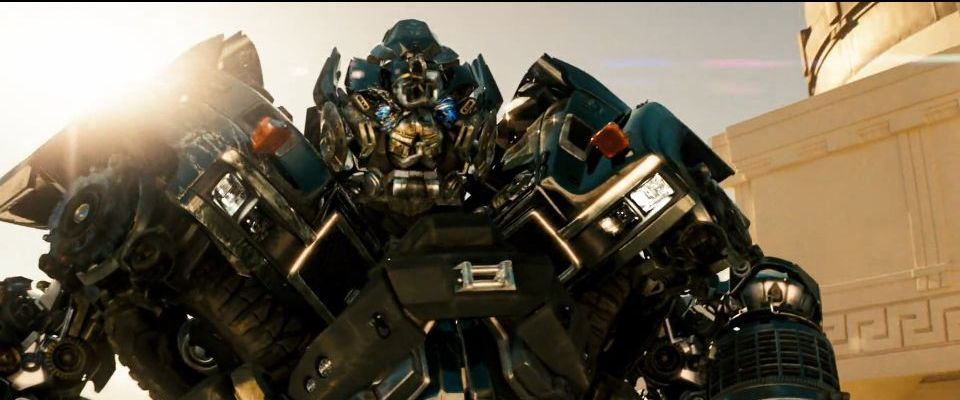  Ironhide is, of course, designed to evoke dirty Harry. His arms and legs are every bit as incoherent as any Decepticon, but pay particular attention to the chest area, the part which, and this is important to remember, along with the head is always going to draw the absolute most visual attention. The designers generally don’t gave a particular gently caress about the spatial coordination of where various vehicle bits end up, but notice they took care to make his chest actually resemble the front end of the car. The side fenders are there (if at an odd angle to each other), the headlights are there (pointed inwards), the bumper is there (twisted and inexplicably shrunk), there’s bits below the fenders that resemble brakes or hubcaps, he has tyres and even a license plate. All the bits are there and even in roughly correct relation to each other, but everything is just scrunched up enough to make it look, no, not like he transforms into a car, but rather like he’s specifically wearing the car as a leather jacket. Now, the reason I included two shots here, one from the first movie and one from the third, is to highlight a couple of differences in how this design is presented. Ostensibly, they are two very similar shots: Close-up on Ironhide as he’s speaking, focused primarily on the upper chest area. The differences however, while subtle, are very significant. One major thing is the camera. In the first shot, it’s panning towards him, never quite perfectly centring on him, then immediately panning away. The shot in general isn’t really devoted to him specifically, but involves three of the Autobots all standing near each other. The huge glaring sun obscures much of his shoulders, and the lighting in general causes many of his parts to sort of meld together. In addition to all that, he’s holding his arms (and guns) close to his body, obscuring the shape of his chest and confusing his silhouette, and the chest itself is cut off at the bottom, leaving out even more of its shape and obscuring the number plate. The second shot is nearly static and focused even more specifically on the chest area, the cold-blue lighting causes the silver parts of his body to reflect and stand out much more, and he’s holding his arms far away from himself, letting the more potent details of his design speak for themselves. Even totally disregarding the differences in rendering quality, it’s a so much nicer shot. Even though it’s the exact same CGI model, the second example is significantly more visually identifiable and just plain nice to look at. The third movie is basically all this all the time. It’s obvious that they became much more confident in their ability to make a CGI model look good on its own, and discarded a lot of the obscuring techniques that made the first movie so hard to follow visually.* This can be seen not only in the way the existing characters are presented, but also in the new guys’ designs: Autobots and ex-Autobots at least use significantly more smooth lines and flat shapes than they would before. Which brings me to the probably most important part of design period: Faces. *Which makes criticisms of the films being visually incoherent applied to the trilogy as a whole feel rather hollow and really a product of projecting expectations, honestly. It always comes back to faces, or perhaps, a lack thereof. No amount of incoherent visual detail on the arms and legs can make a character seem quite as alien and horrible as a deformed or unrecognisable face does. Hence, the awful “shredded insect” look sported by Ironhide and co. It’s a powerful tool that makes it virtually impossible for the audience to build proper empathy towards the character. Ironhide resembles Harry Callahan, right? Well, now imagine Harry walking around asking punks if they feel lucky, only he has a bunch of unrecognisable shapes where his face should be. Terrifying stuff. Of course, while the second/third movies keep this approach for the Decepticons (who always remain alien and unfathomable), the new Autobots work a bit differently. Although their faces feel a bit more immediately human at first, they have this odd quality where they conform to a particular stereotype so fully that they cease to feel like people’s faces at all, oddly soulless and empty. It should be noted, for example, that you can’t actually see any of the Wreckers’ eyes. The two big exceptions are, of course, Optimus, who at least in the third film has an unusually humanlike face, but has a convenient mask that he can just put on when it’s time to do something spectacularly awful, and, and here we go again, Megatron.  I find it pretty funny that concept artist Josh Nizzi ( On pictures, Megatron’s face is among the most hideous and unfathomable, but with the constant attention and effort put to it in the third film, something magical ends up happening and Megatron basically turns into a prawn from District 9. No matter how gross he may be, something about the way he moves and emotes makes him incredibly humanlike, in a way. That reminds me, there’s something I failed to mention before.  There’s a weird intermediate step in Megs’ transformation where, after giving off a beastlike roar, he tries to raise his entire cab off the ground, then slams it back onto the ground hard. It really does look as though the cab itself was the head of some kind of animal, right down to the tarp fluttering behind it forming an enormous mane. The reason I bring this up specifically is because we’ve seen a heavy, beastlike character slam his head into the ground while roaring during a transformation sequence that felt more painful and unpleasant than elegant and magical in a desert setting before: 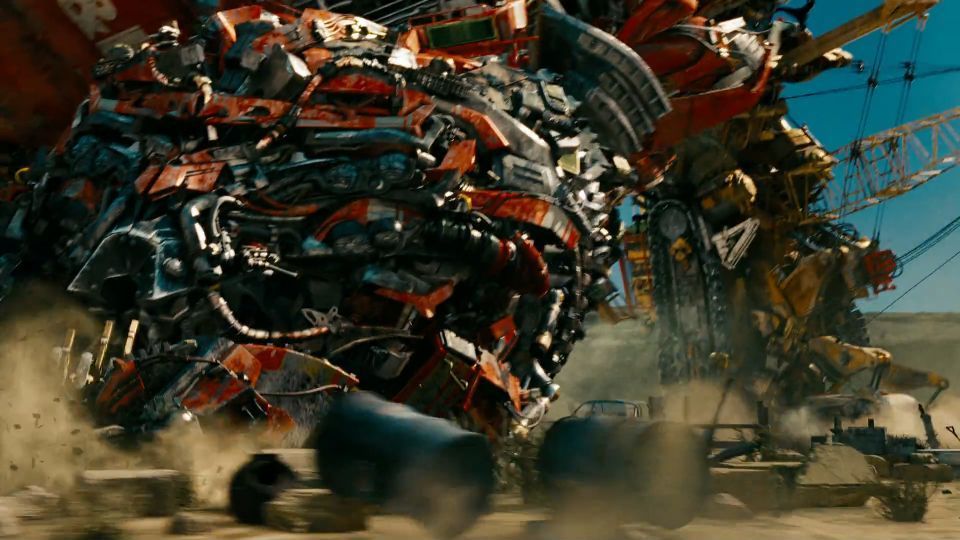 Just yet another visual link between the two characters. 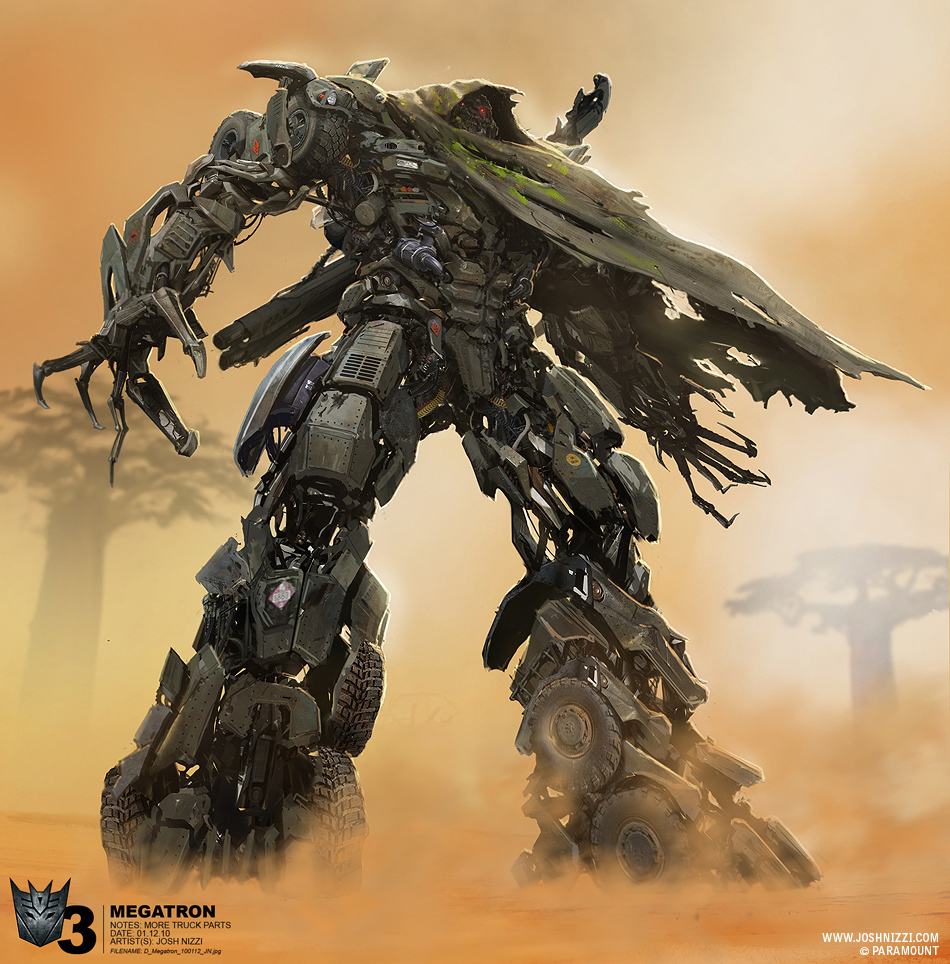 Really, there’s just so many things about this design that work for me: It really is probably my second favourite character design in all of visual media (the first is Utsuho Reiuji from the Touhou series. Don’t ask.) it’s not pretty, but it’s incredibly emotive and multifaceted and full of little details and references. I just admire all the work and thought that went into bringing this character to life, and my greatest regret about him is that he couldn’t find his way into a movie I can actually recommend people to watch. So then, to review, here’s why I feel the general aesthetic of the films works: - It plays with the viewer’s perception, causing the CGI models to look, well, certainly not more real, but a different kind of fake that works better within the context of a film. - The high amount of detail gives an additional impression of scale, making the models look massive even when there’s no reference objects around them. - It makes the characters more alien and distant, making it harder to immediately accept their viewpoints, which is, for better or for worse, clearly something the filmmakers tried to accomplish. - It adds multiple important thematic elements, like the robots looking like they’re wearing cars as clothes. - It adds more detail and nuance to a few characters and is in part responsible for the most detailed and nuanced character in the trilogy actually becoming such. - It’s unique and immediately recognisable, and its hypermodern sensibilities allowed it to really take root in our culture, both making the Transformers series even more of a “thing” in people’s minds and showing concisely the amount of influence the movies had. - It makes for some pretty kickass toys. - Really, once you allow yourself to get used to it, it can just be pretty nice to look at, in its own way. While I’m at it, here’s some more neat concept art. 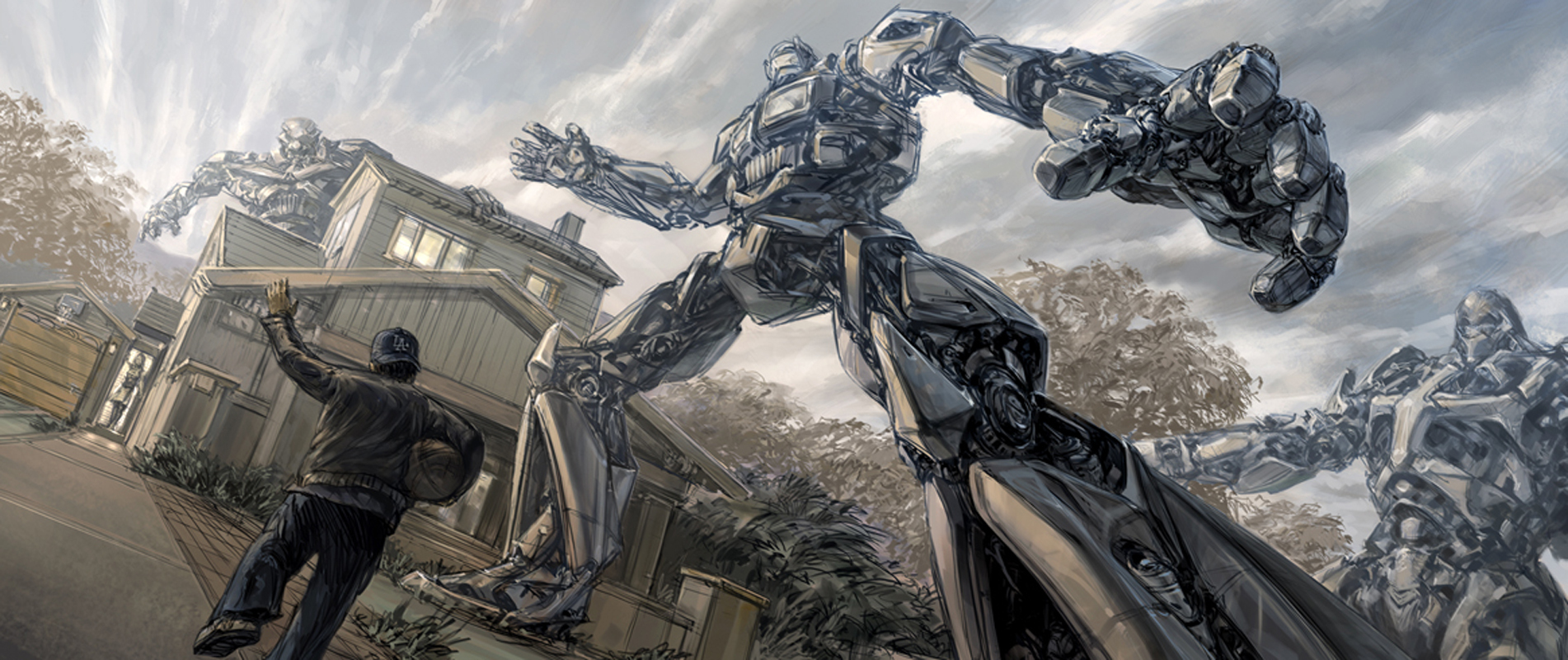 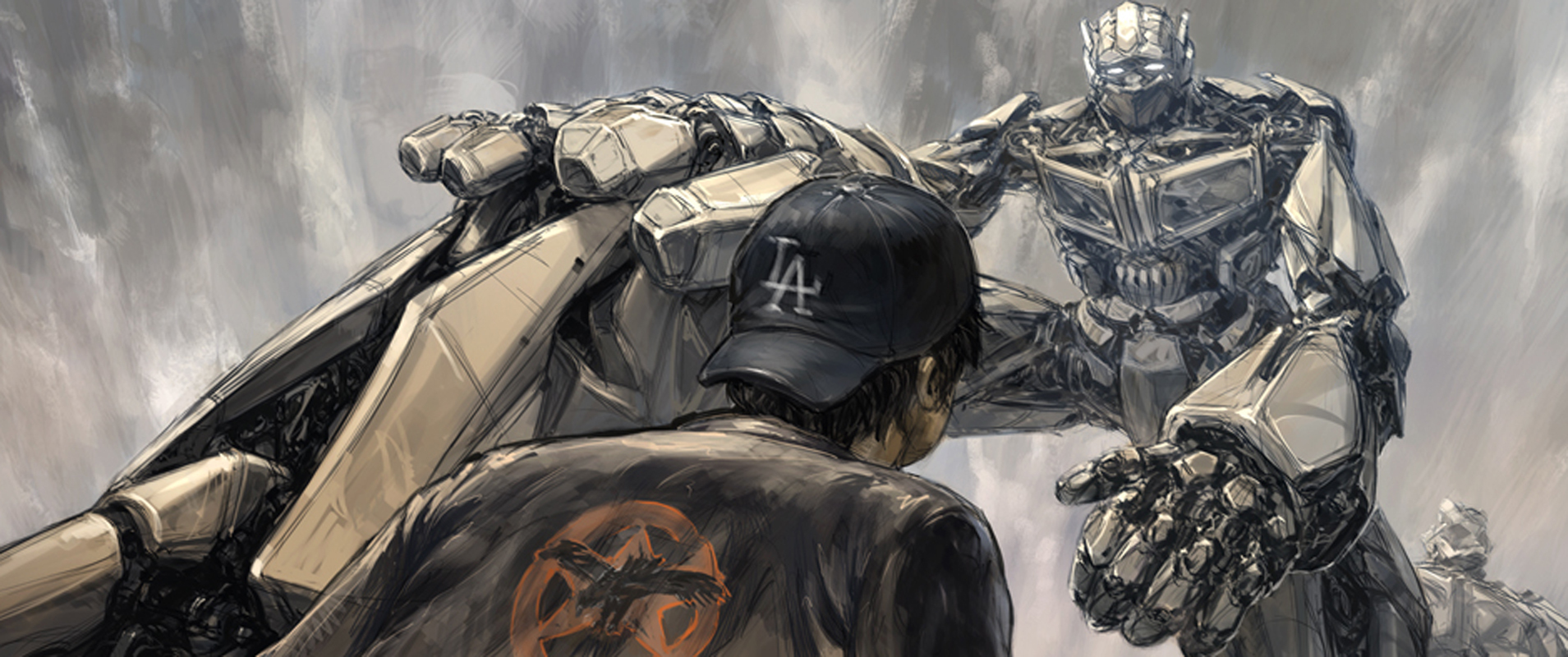 Some very early storyboard art by Tony Kieme. I actually really like the framing and ambiance of these pieces (I particularly enjoy the tilted angle of the first one – the robots on the right side have so much visual mass that the entire planet seems to buckle under them) and I would absolutely not object to the entire film having been made with this approach. Thought the Constructicons in the movie were weird? You should see some of the stuff that didn’t make it in. Another concept artist called it “freeform robot design” and yeah, you can pretty much see that. It really shows that after the success of the first film, they became confident enough to really start pushing aesthetic boundaries and just generally loving around. The return to more “reasonable”, humanoid designs for the third film is both a blessing and a bit of a shame. One of the dropped ideas for the second film was an enormous combiner made of millions of tiny insect transformers (like the one Sam squashes at the end). Having one of the Decepticons be a literal plague of locusts is a terrifically biblical idea that I think would have worked perfectly in ROTF, but instead we got Devastator so I can’t really complain. 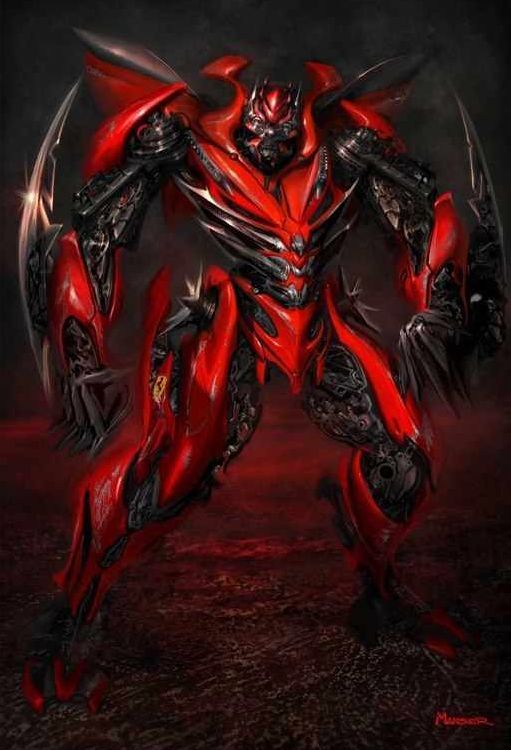 Mirage / Dino. Remember this guy? I don’t. Anyway, notice the somewhat abstract nature of the piece. He’s barely recognisable as a car at all, and the mechanical detail is pretty much just an applied texture. He totally lacks physicality. Instead, the piece focuses entirely on showing the flow and lines of the design. It’s a good showcase of what was important to the artists at this stage. (contrast with the much more technical concept art for the first film.)  THE BEST LASERBEAK CONCEPT. There’s actually a bunch of neat laserbeak concept art, but I guess in the end they just wanted him to look ugly and unpleasant above all else. 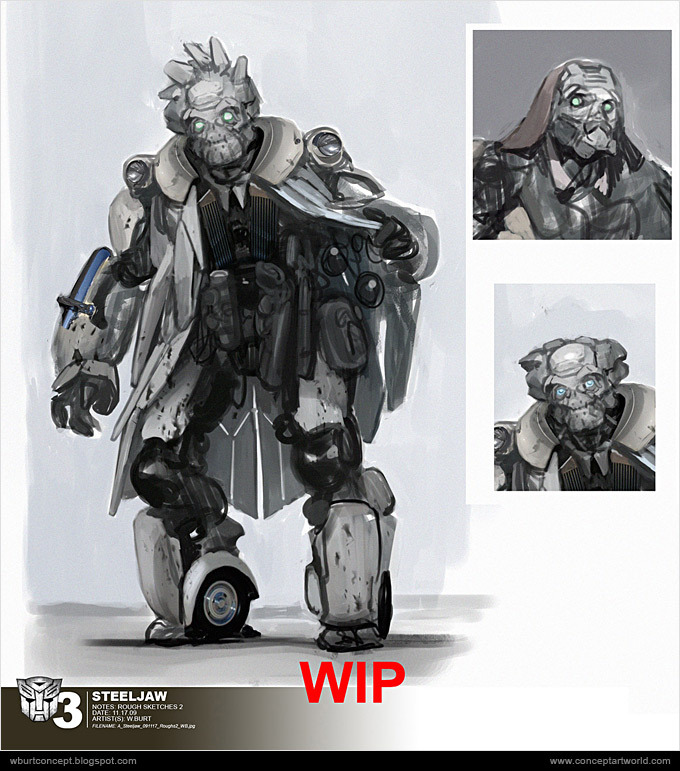 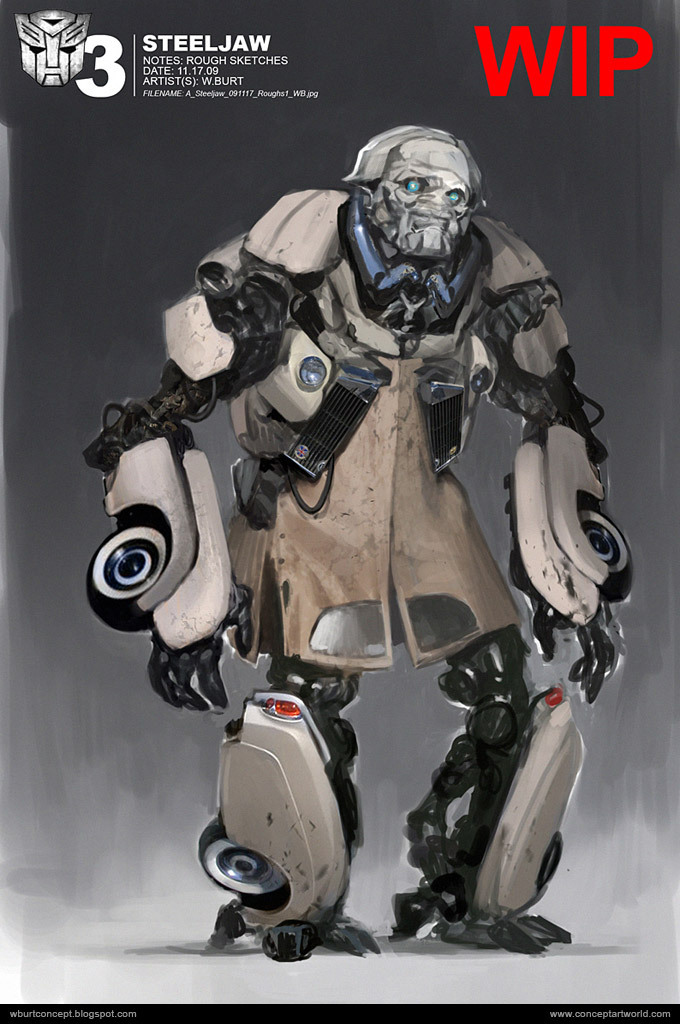 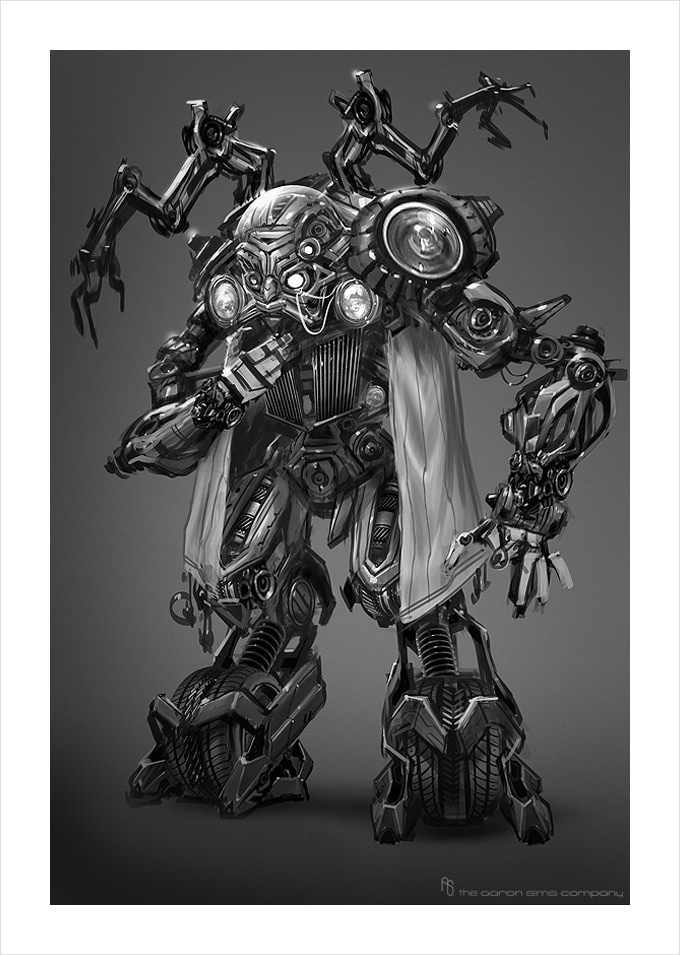 Que also went through a number of very distinct designs, ranging from “actually sympathetic looking” to “horrible nazi doctor”. I can see why they went with his final design in the end, but I also won’t lie about it being one of the least aesthetically worthwhile ones in the trilogy. It seems he was also going to be a different model of car, but I’m not car nerd enough to identify it based on the visible vehicle bits.  I, uh, have no context for this. Are we still looking at DOTM concepts because 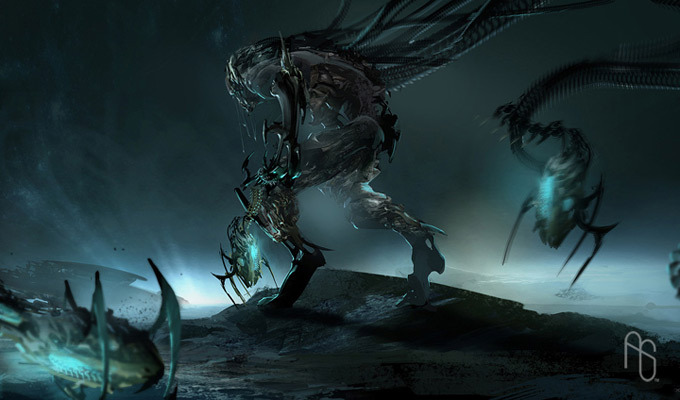 Wait aaron sims what are you doing do you even remember what movie you’re working on 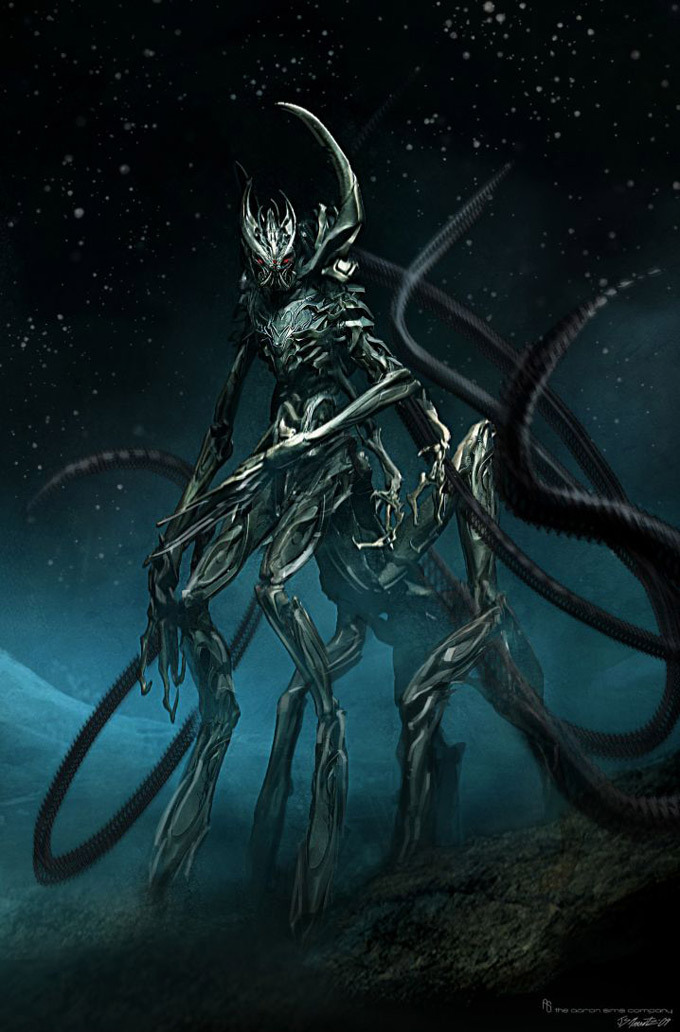 what the hell is going on here aaaaaaaaaaaah I haven’t found any site that has all the available art collected in one place, so in case you’re curious to look at some more, I compiled a list of all the individual artists’ pages I could find. Transformers 2007 Ben Procter (has some additional information, worth reading) Revenge of the Fallen Wesley Burt Ryan Church (the “scenery and setpieces” guy) Stee Jung (it seems his actual site went down, but his silly Constructicons can be found here) Josh Nizzi (hired for being good at fanart, now pretty much the main robot designer) Paul Ozzimo (robot concepts, more on his [http://www.paulozzimo.com/]irritating to navigate flash website[/url]) Ben Procter (mostly curious unused concepts) Dark of the Moon Wesley Burt (some of those Optimus super mode ideas floating around are pretty crazy) Joel Chang (some space stuff) Ryan Church (some Shockwave) Warren Manser (some vehicles) Josh Nizzi (did I mention I love this guy?) Aaron Sims (what is this i dont even) One last part left.
|
|
|
|
It always frustrates me when people bad-mouth the movie designs. I think they're great, and agree with all the reasons you pointed out, Terry. Personally, I think the best designs are all found in the first film - I think the second and third films just went a bit too out there and seem incongruent with the designs from the first film. I remember making a big post about my personal opinion on them in the previous thread, touching on Arcee, the motorcycles and the Constructicons. However, I don't think there is anyone who will disagree with you about Megatron's third design - it really is wonderfully evocative and I think it's a bit unfortunate that we only barely see it.
|
|
|
|
|
Corsec posted:I think that Megatron's intentions towards humans in particular are really important for understanding his values/motivations in this film. Meg doesn't symbolically eliminate Lincoln but takes over for him. Check the form of his expression: he destroys the lily-white, Grecian statue of the caucasian, American president and fills that spot with his own body. Meg's body has, as we know, been coded as African, feminine, homeless and whatever. And recall that these are symbolic clothes: Meg could look like any large vehicle but chooses to be an authentic version of the decidedly inauthentic Optimus. He wraps himself in chains! Anyways, the point is that the Cybertronians are (pagan) gods. The scene where the NEST dudes target their eyes and legs is mythic imagery of David and Goliath, Odysseus and Polythemus, and so-on. Great Mythic stuff. Lincoln's statue rests in a temple - and Meg isn't destroying Lincoln so much as surpassing him, taking over from him. Megatron aspires to lead his people to a brighter future. He doesn't specifically target Optimus at all. Look at how he stares up at the planet he hadn't seen in who knows how long. Megatron has aspirations, and is not merely acting out of envy. Cybertron in this film is presented with the same imagery as Krypton in Man of Steel or Elysium in that film. Bringing these symbolic kingdoms to Earth can be apocalyptic or revolutionary, depending on how it's done. What if we mirror Elysium directly, and make everyone an honorary Decepticon? And then, isn't that what Meg is doing by approaching Optimus - to organize an alliance with humanity? As a flipside to the surveillance imagery, eye violence imagery is nearly as prevalent as violence against faces in the film. You might recall that the opening title sequence is a zoom into Sentinel's eye, and then further into an abstract/metaphorical spiraling abyss of whirling gears and blades - it's the abyss of subjectivity. Transformers' souls happen to 'look like' Shockwave's worm. The last we see of Megatron is the fire dying out in his remaining eye. It's the eye on the undamaged side of his face, the same side that he turns toward Carly and the camera after her motivational pep-talk.
|
|
|
|
Chucat posted:Yeah I remember that part as well, which is what justified all the stuff I mentioned in my previous post, since he was just blatantly exaggerating so they'd feel even better about fighting weaker, crappier Persians who didn't have giant crab men with them. I guess I don't understand the question then.
|
|
|
|
Terry van Feleday posted:
Hard to tell with the last one, but the first two is definitely a Rolls-Royce.
|
|
|
|
Terry van Feleday posted:I just admire all the work and thought that went into bringing this character to life, and my greatest regret about him is that he couldn’t find his way into a movie I can actually recommend people to watch. I'd say this thread and its predecessor represent a pretty good recommendation for watching the films. Milky Moor posted:It always frustrates me when people bad-mouth the movie designs. I think they're great, and agree with all the reasons you pointed out, Terry. ... However, I don't think there is anyone who will disagree with you about Megatron's third design - it really is wonderfully evocative and I think it's a bit unfortunate that we only barely see it. I agree. Even the moments when the designs are just whirling blurs of machine parts are beautiful to me- like a visual representation of Autechre music, or this awesome music video/visualization: http://vimeo.com/40162986 Lord Krangdar fucked around with this message at 18:55 on Oct 3, 2013 |
|
|
|
Lord Krangdar posted:I'd say this thread and its predecessor represent a pretty good recommendation for watching the films. At the weekend I was put on the spot about my opinions on the Transformers trilogy, and I settled for "bad, but in an interesting way". Terry, thanks for completing this wild ride with us. It's been fun.
|
|
|
|
Petition to combine this thread and the earlier one into one magical pdf we can keep for future generations.
|
|
|
|
Party Boat posted:At the weekend I was put on the spot about my opinions on the Transformers trilogy, and I settled for "bad, but in an interesting way". Transformers 3 is a genuinely good alien invasion film along the lines of War of The Worlds and Battle: Los Angeles that is continually interrupted by the obscene presence of the Autobots. It's the film's running joke: that any poignancy is cut short by Optimus stepping into the frame in his trumped-up idiot uniform, or Bumblebee appearing to snatch a falling character from the air (a recurring image). People have called Bay a nihilist, but his appreciation of 'the troops' seems genuine. He's just as genuinely distressed that they fall into line behind this Optimus figure. Consider that Sam's search for Carly in Chicago is the same scenario as Cloverfield, and consider how that film ends by comparison. One thing people miss in Cloverfield is its fairly seamless transition from being a 9/11 film to an Iraq War film, and you get the same thing in Transformers 3. There's the imagery of the skyscrapers being toppled, sure, but the spectacular violence is mostly distraction, chaos designed to disrupt the existing order so that a 'fortress' can be built in its place. Remember when all those advanced terrorist gunships engaged in a prolonged shock-and-awe bombing campaign? 9/11 was a lot of things, but it wasn't a colonization.
|
|
|
|
Terry van Feleday posted:
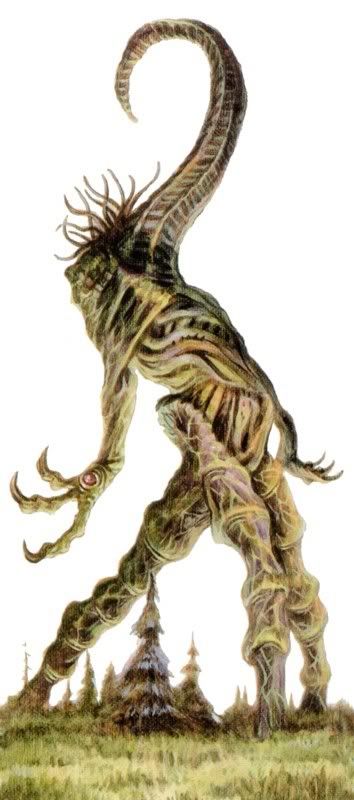 The design of the Dweller in Darkness in one of the Shin Megami Tensai games is also almost spot-on: 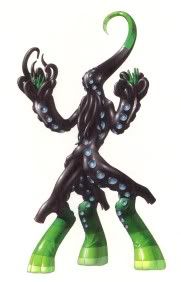 If we look at some of the other concepts Sims did, we also find  a Star Spawn  and uh  Yeah I got nothin' on that last one. Wales Grey fucked around with this message at 02:54 on Oct 4, 2013 |
|
|
|

|
| # ? Apr 20, 2024 06:18 |
|
Thanks for seeing this though, this weirdest and most wonderful thread of all time. What I personally get out of these films is drat unsettling. More than anything else, more than Sam's transformation to a sad and hollow shell, more than Megatron's arc as the true protagonist of the trilogy, I get the feeling that Optimus Prime is the god that we (Americans) deserve. A psychotic war god who falsely claims to want peace, disguises himself in the symbols of the common man, gives empty speeches about freedom and protecting our way of life, who then proceeds to mercilessly rip his helpless enemy's face off. And we love him for it and can't wait for him to do it again in Part 4. And that is scary as hell.
|
|
|









